Harvesting your own black walnuts is a labor of love gaining popularity with more and more foragers. This post will show you everything I've learned: harvesting, cleaning, storing, cracking, cooking, and everything in between.
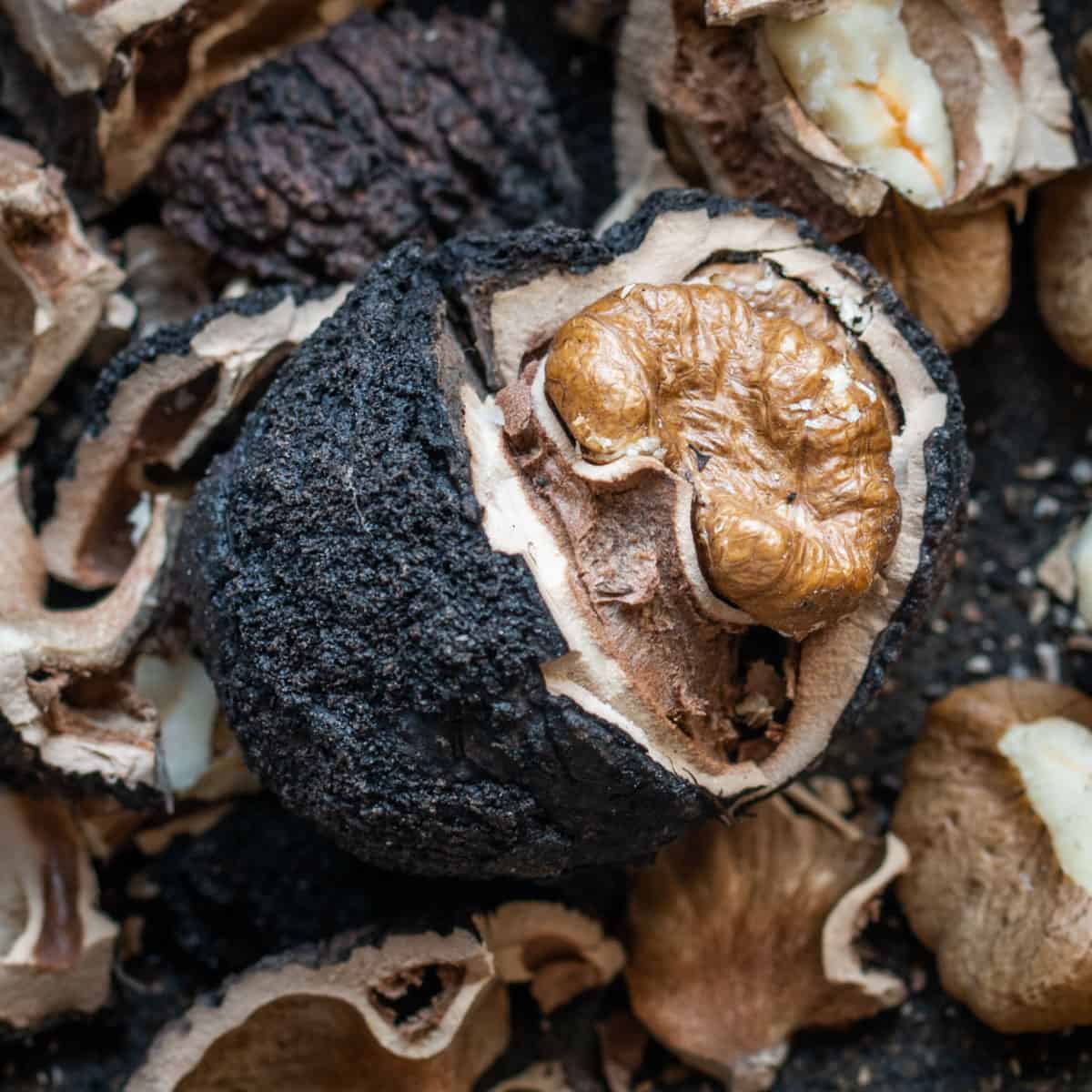
Like a lot of other people, I have memories of tripping and stepping on ugly, gooey black walnuts in the yard when I was growing up. They were a serious pain when I had to mow the lawn, and I thought they were weird, not food--no way they could actually be related to regular nuts that we eat, right?
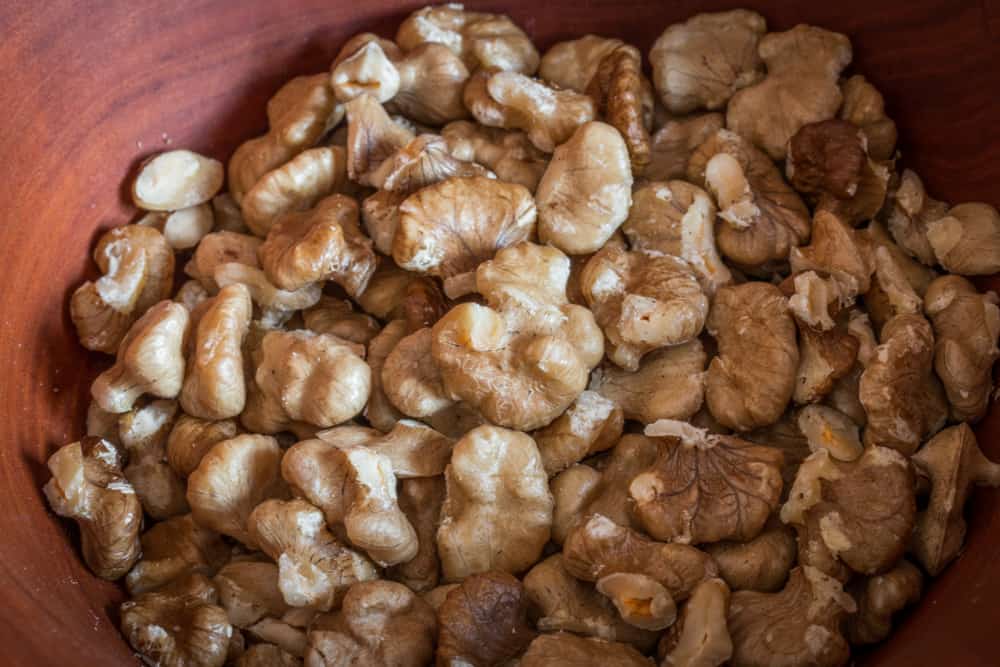
As I worked my way through the culinary industry, black walnuts took on a new identity as a treasured, expensive product that was near impossible to source. When I was opening up my first restaurant, I looked at buying them from an exclusive purveyor and did a double take when I saw the price tag: over 40$ a lb.
Black Walnut vs English Walnut
Both walnuts are related and are in the Juglandaceae family. Black walnut trees are Juglans nigra and are common wild walnuts. and English walnut trees are Juglans regia-the same walnuts sold in grocery stores.
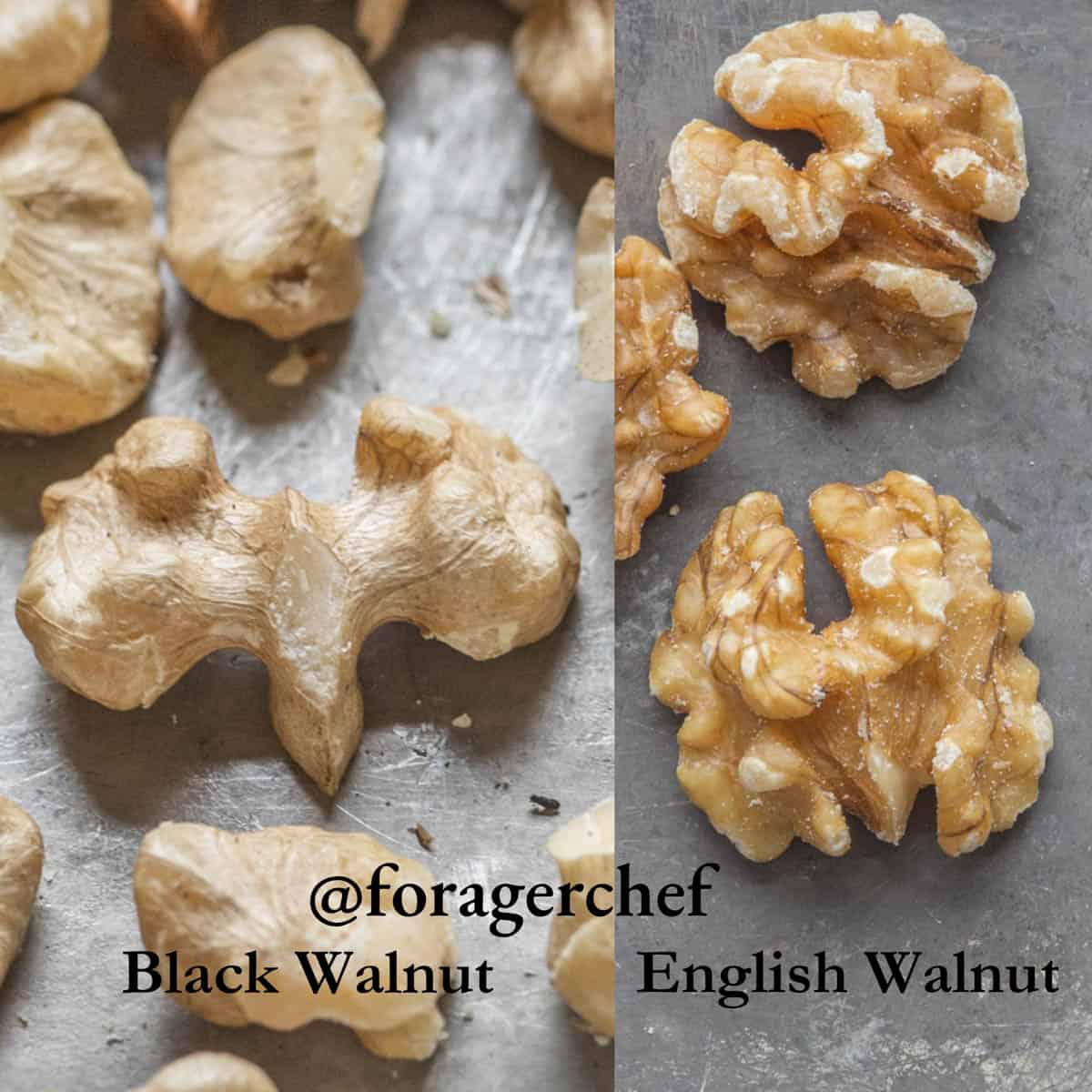
The trees are slightly similar and both have opposite, pinnate leaves but the nuts are very different. The pictures below illustrate some differences between both trees.
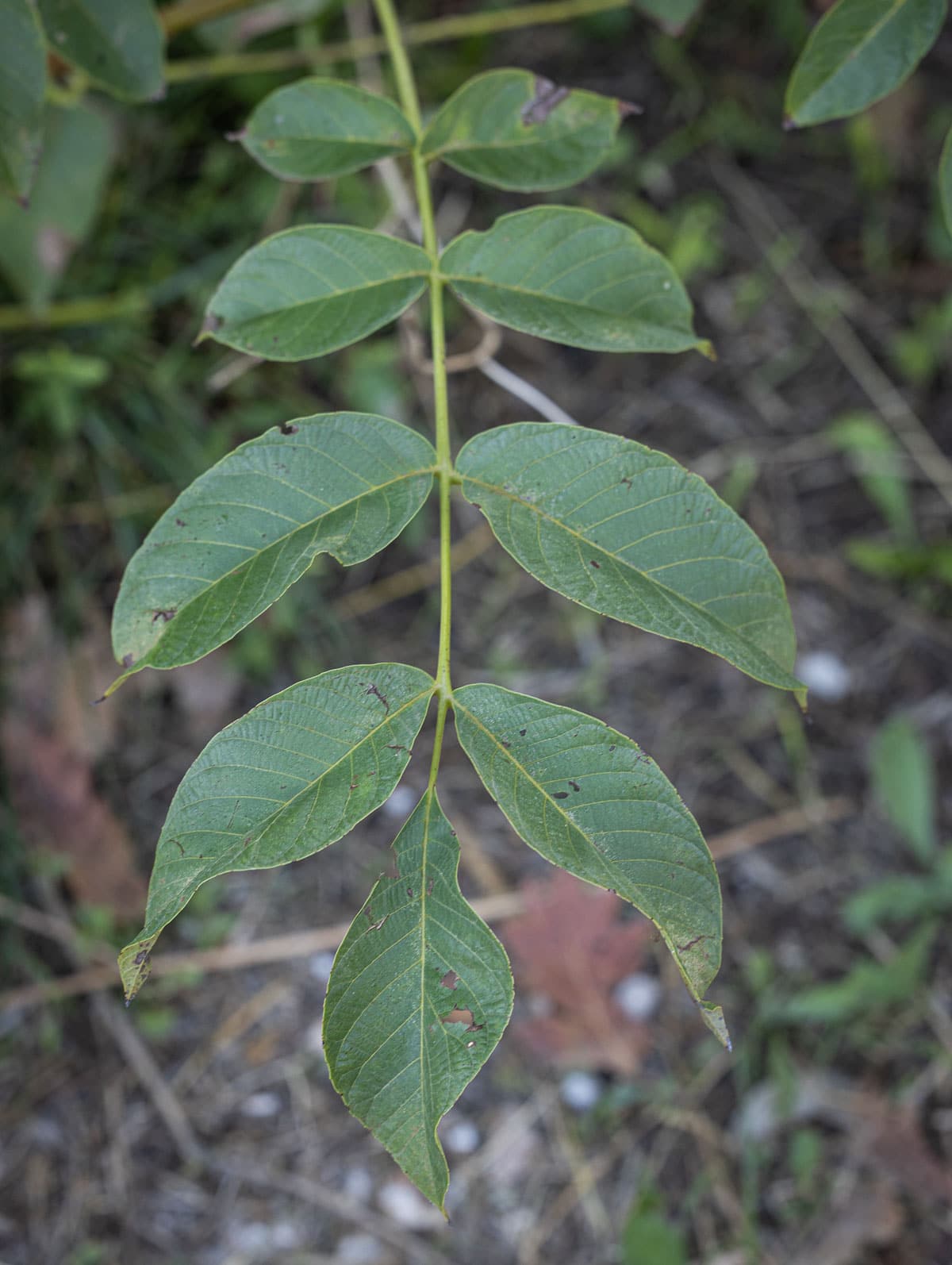
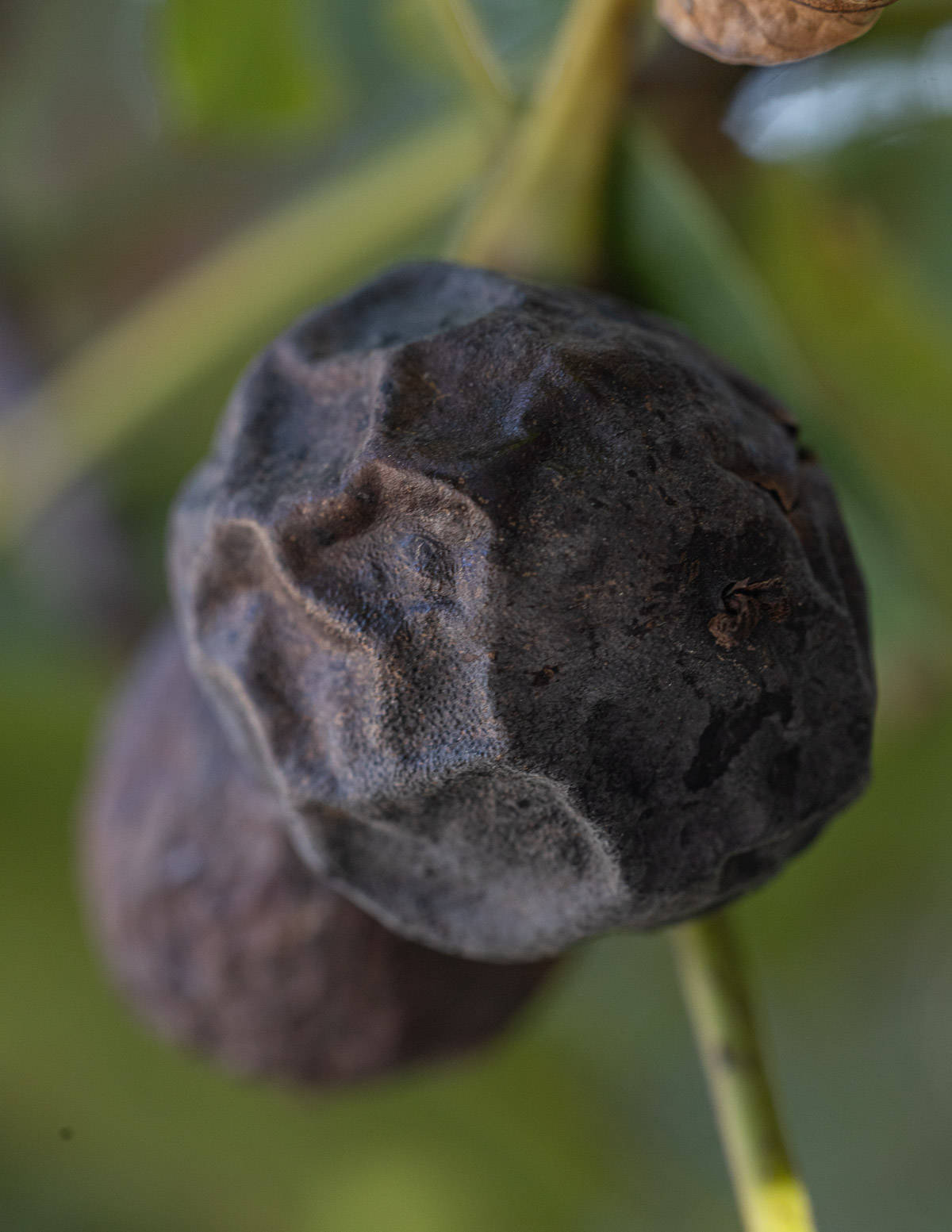
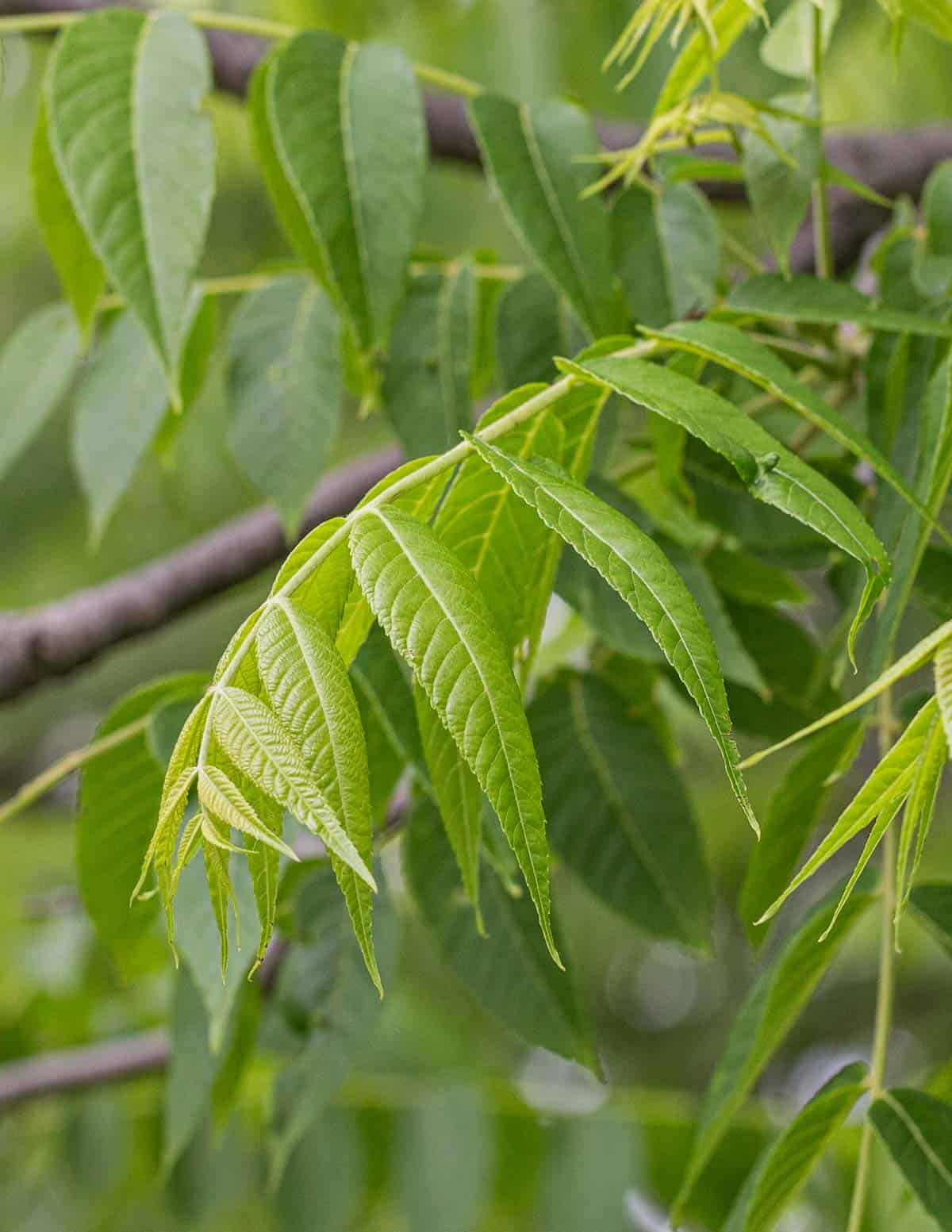
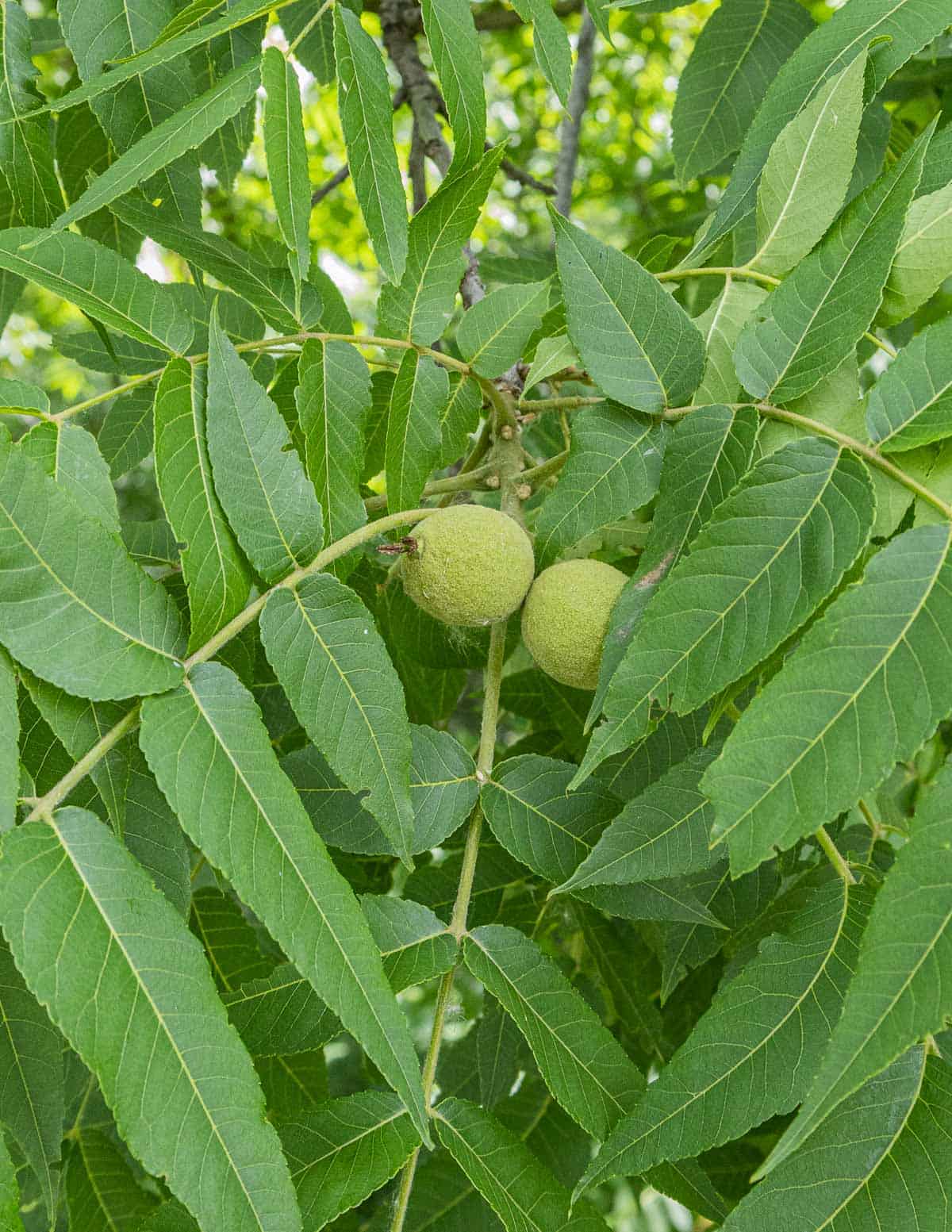
English walnuts have very thin shells compared to black walnuts, and the flavor is very mild, where black walnuts have incredibly hard shells and a very strong, earthy flavor. If you like the flavor of both nuts they can be interchangeable in cooking.
Where to Buy Black Walnuts
Hammonds is now the premier supplier of black walnuts in the United States, who sell them at industrial scale at an affordable price. When I need large amounts I order from them. They're also the only supplier that sells black walnut oil.
Hammonds nuts, while available in bulk, are mechanically separated, and they take a beating during the process in flavor and shape. Simply put: cracking black walnuts by hand is how you get the most intense flavored, perfect-looking nuts possible.
Why would you harvest your own black walnuts with large scale purveyors in business, you ask? One word: quality.
You'll be able to smell the bowl of nuts as you crack them, and pressing them between your fingers will yield a fresh, aromatic oil. You'll be able to see black walnuts as a luxury, and brag to your friends about your command of a lost art.
Harvesting Black Walnuts
There's plenty of methods and opinions out there, but after a couple years of harvesting, here's what I've found to be the easiest for me. Once the trees start to drop their nuts around early October, I wait a bit for the hulls to soften before I gather them.
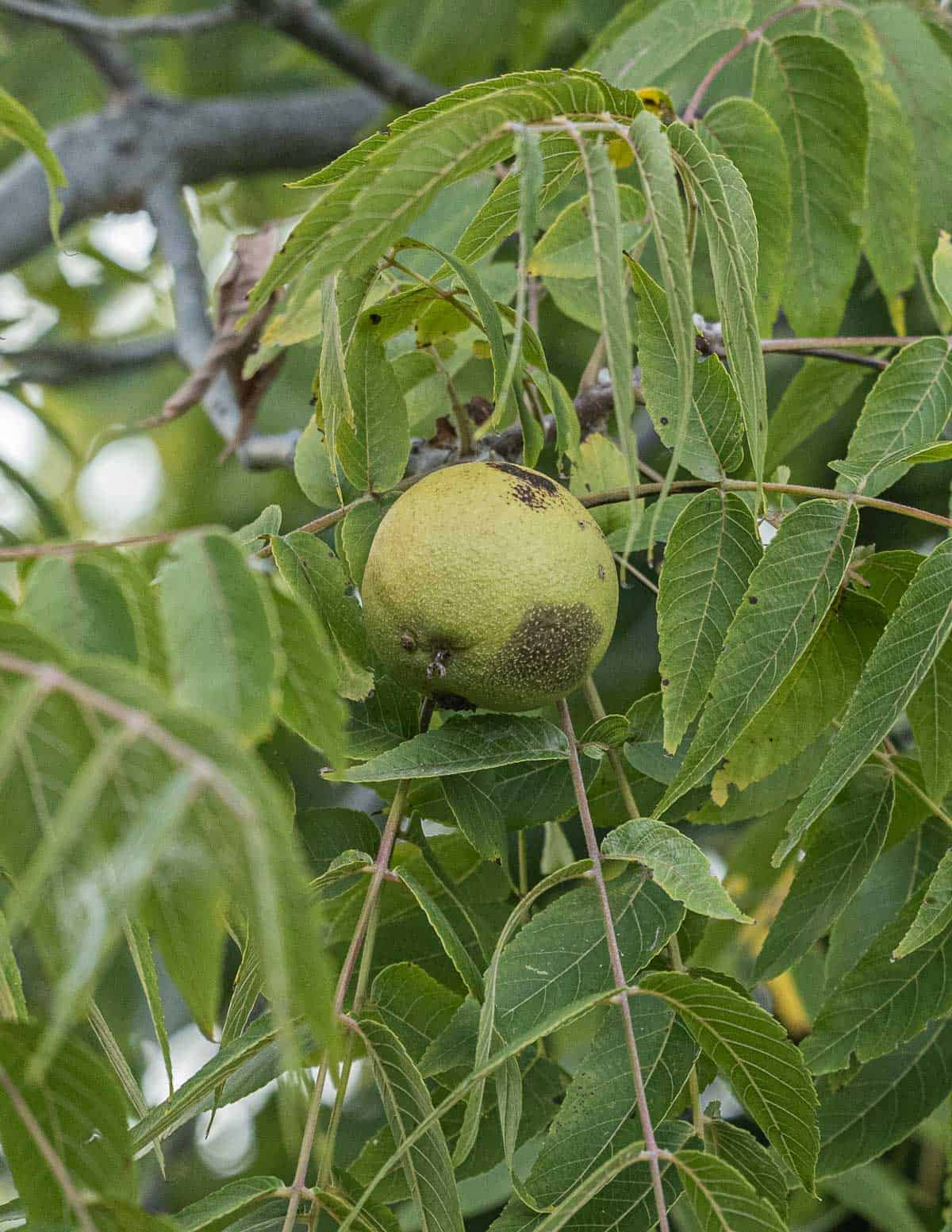
What happens here is that fly larvae will get into the thick green hulls, and begin feeding on them. After a bit, the hulls soften a little. From here, I go outside with a plastic tub, and, wearing gloves and using boots, I rub my heel over each nut, and the once hard green hull simply melts away.
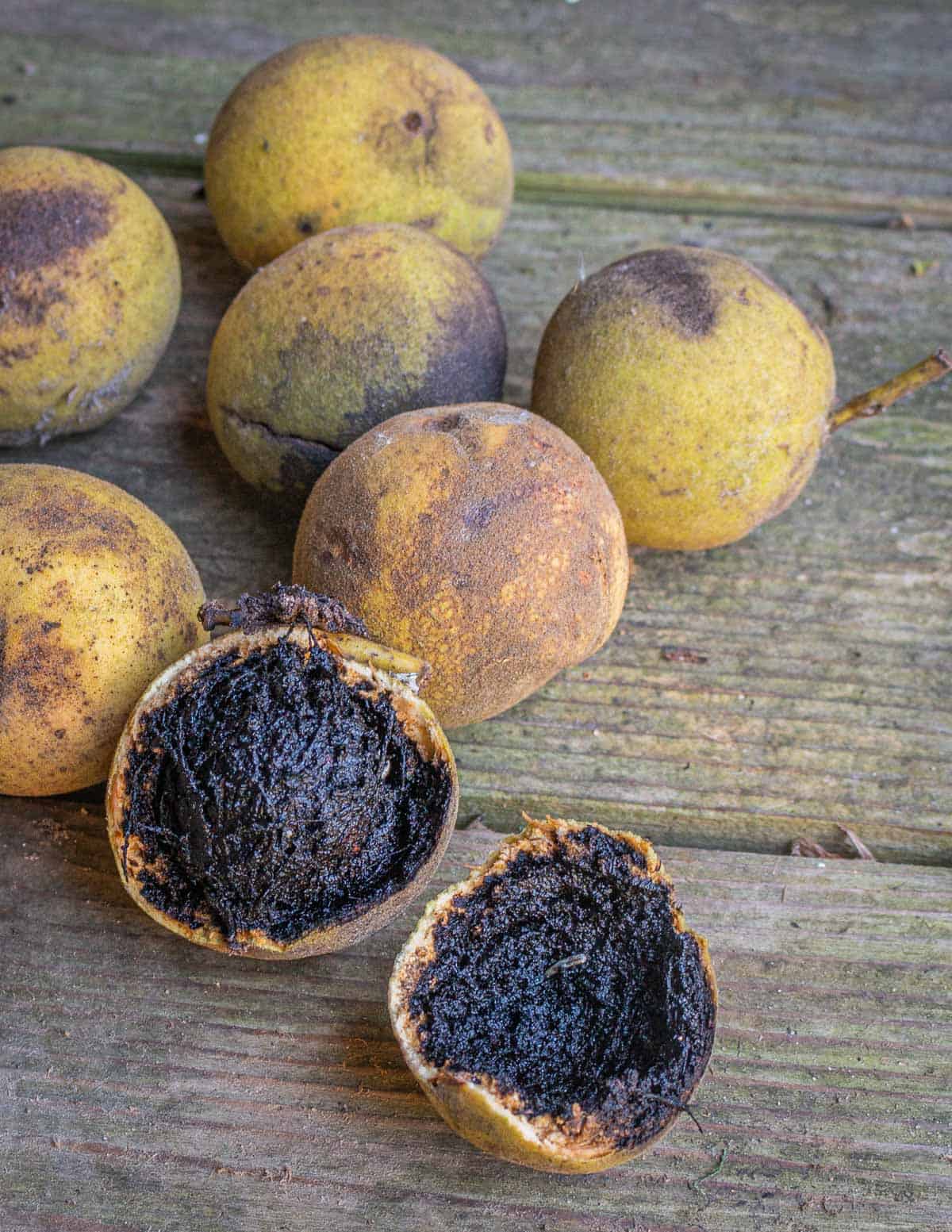
Some nuts may need to be stomped a bit, and that's fine. What's happening here, is that I'm allowing the fly larvae (walnut maggots) to digest the hull, soften it, and in the process do a lot of the work of hulling them for me.
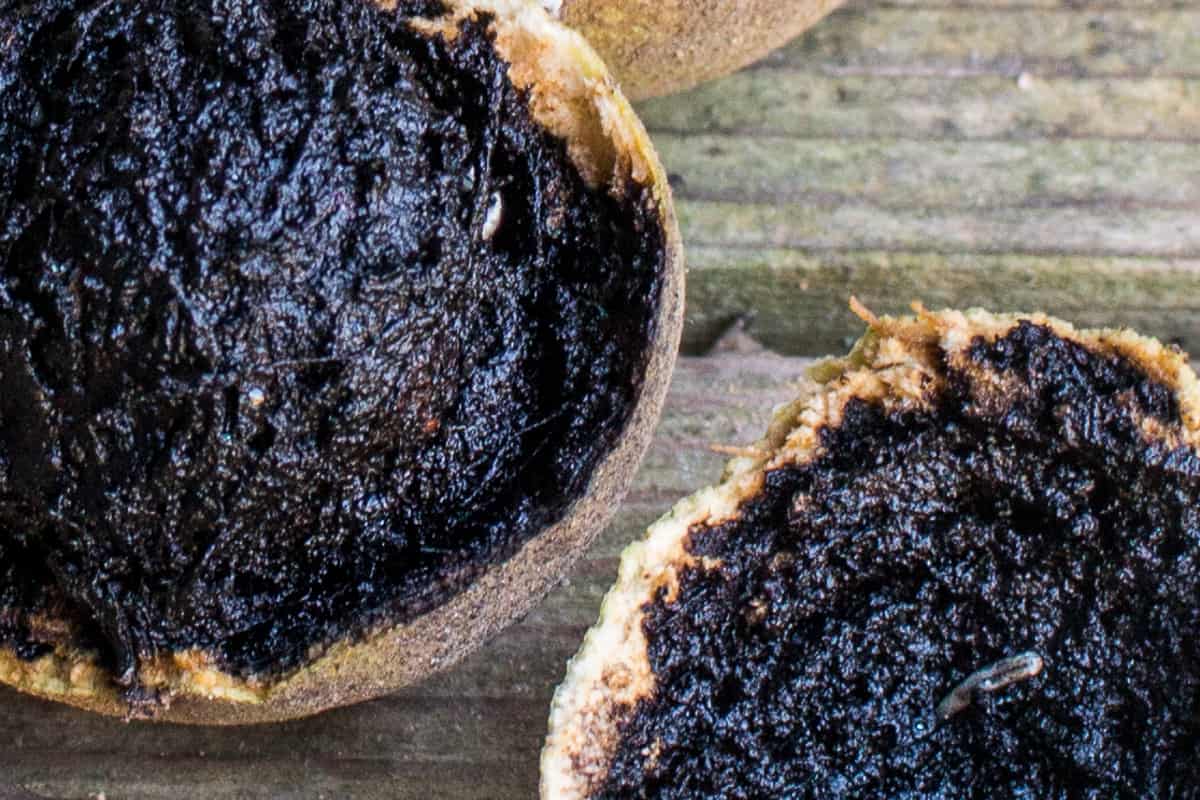
If you harvest the walnuts green, with the hulls firm, you'll need to find a way to remove the hull yourself, and you can find plenty of ideas for how to do that online. My advice, is make your peace with creepy crawlies, and let them help remove the green hulls for you.
Nuts can also vary drastically in size from tree to tree, so you'll also want to look around and find trees you like the best.
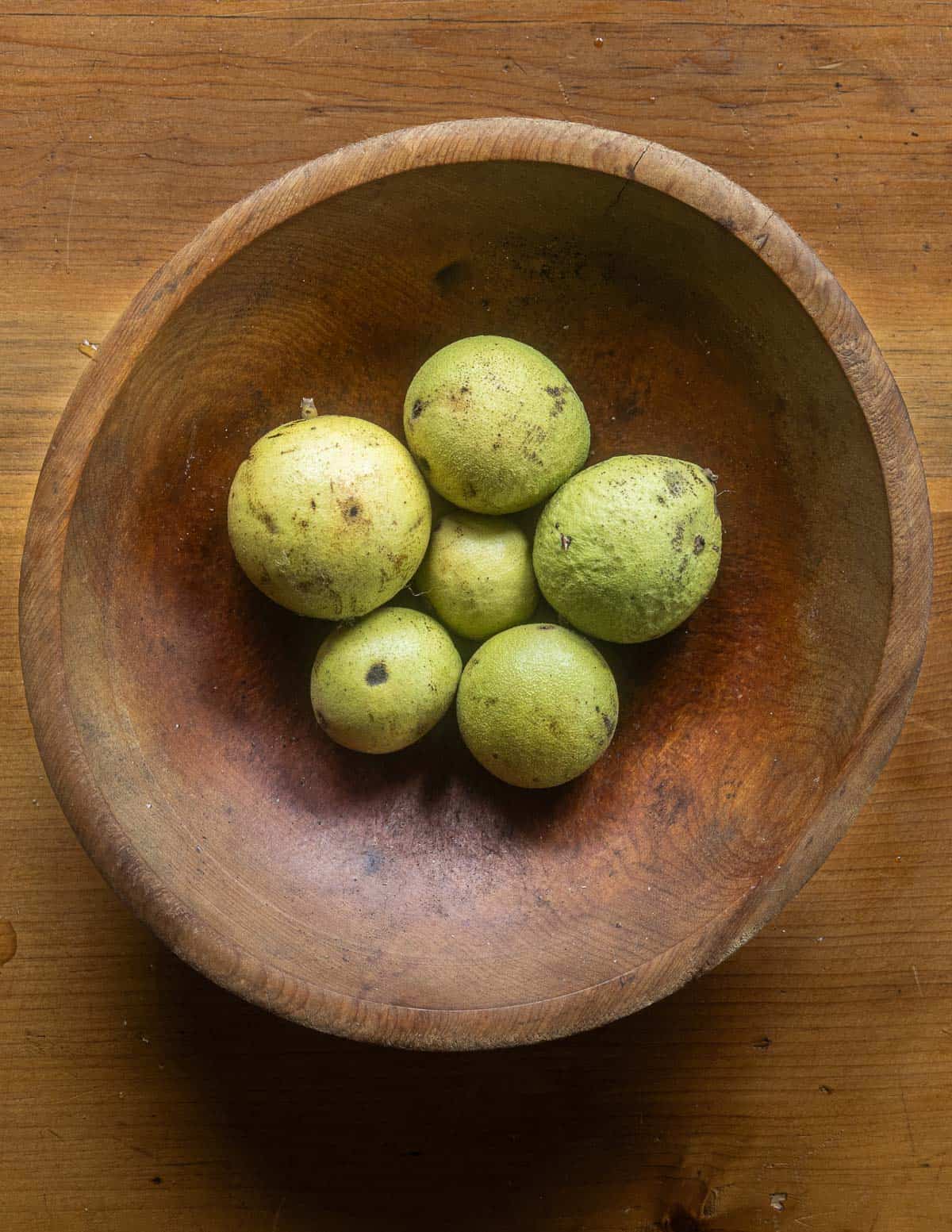
Processing Black Walnuts
After removing the hull the nuts will still be covered in black goop and need to be washed. Fill a big Rubbermaid or plastic container with them, get the hose, and fill the tub with water.
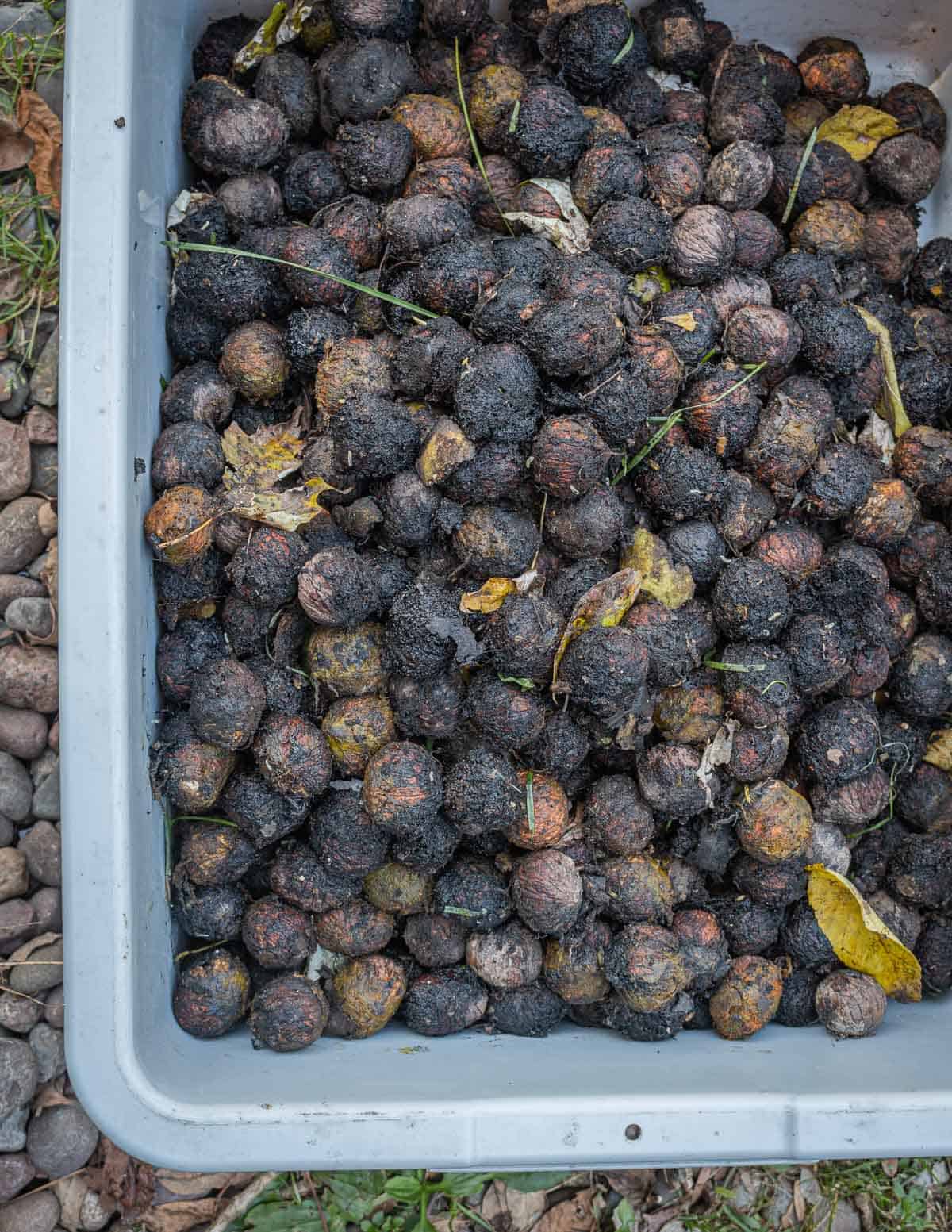
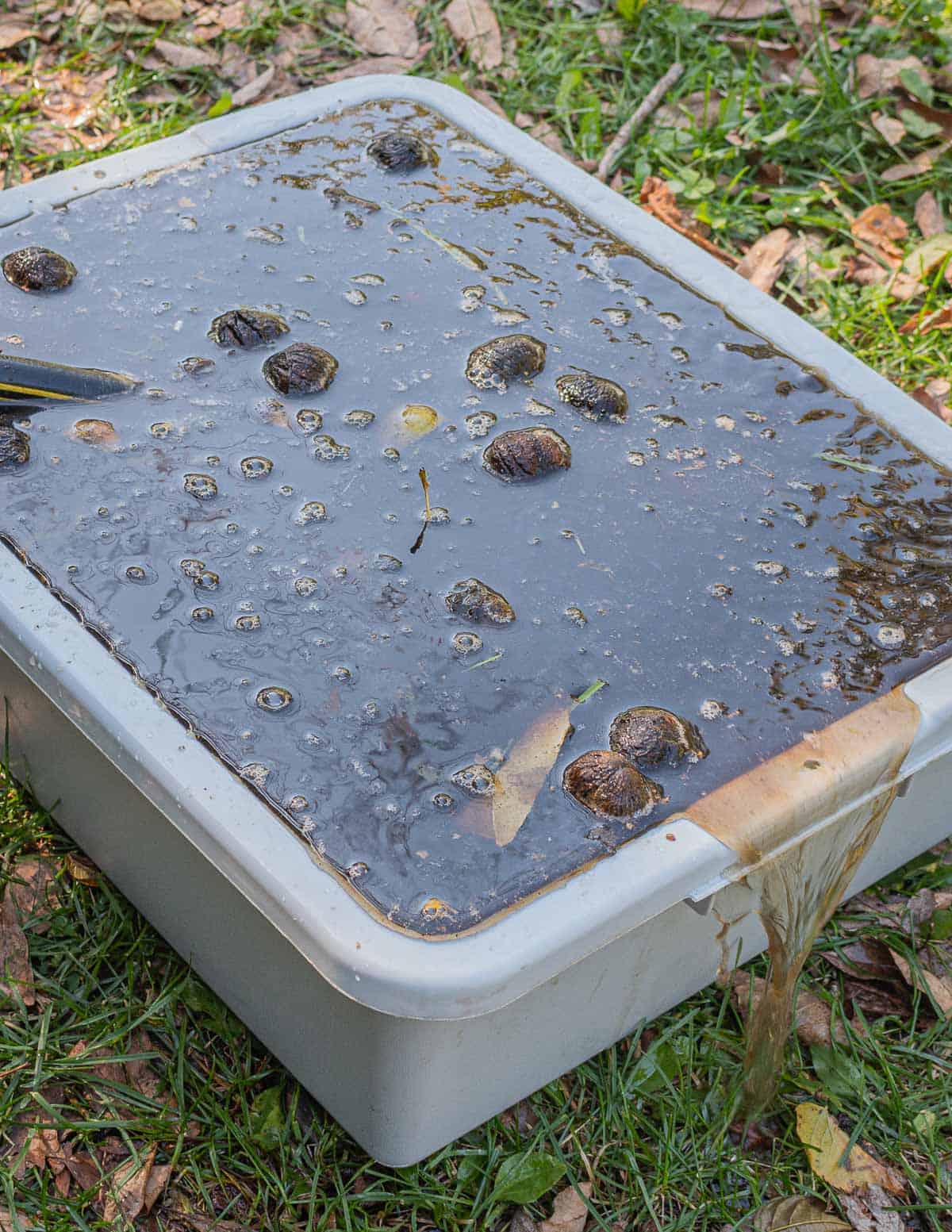
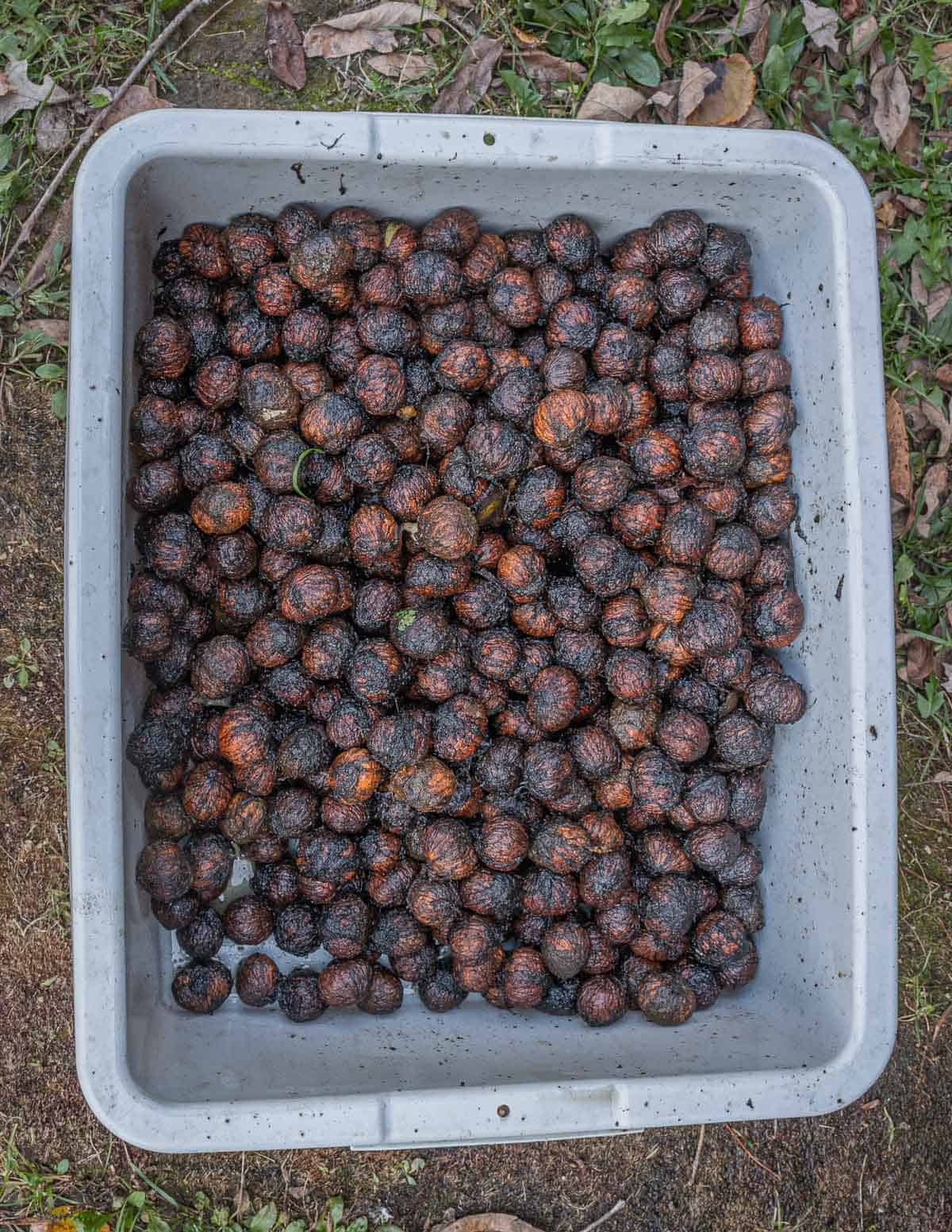
Using a stick or some other crude tool, swish the nuts around in the water to help loosen clinging bits of hull. Dump the water, then repeat the process a few times until the water runs clear.
Discard any nuts that float, and do not leave the nuts in water for longer than it takes to wash them, or they can mold during the curing process.
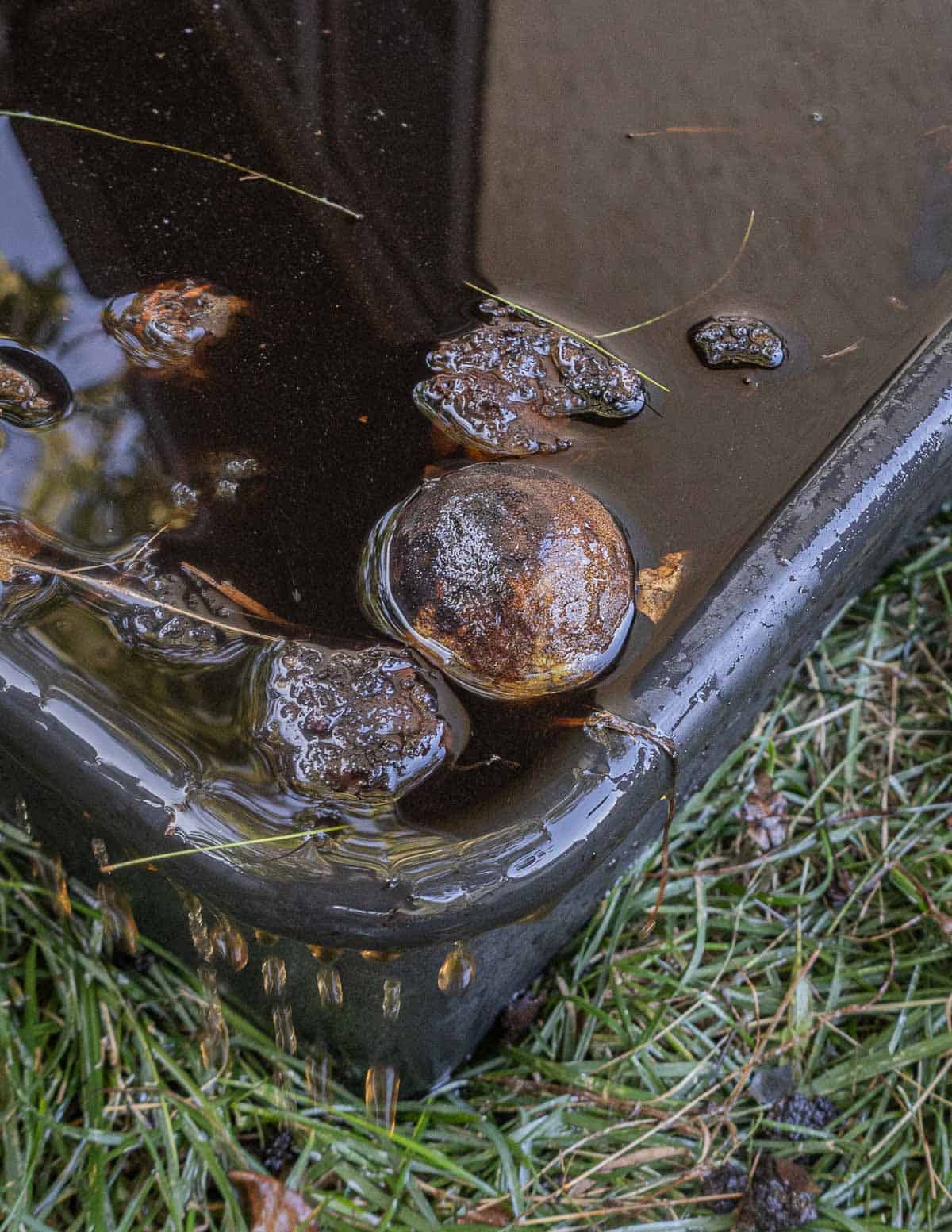
Drying / Curing
Once the nuts are drained they need to be cured/dried. Put the nuts in a wide container to dry in a cool place with ventilation--a porch or garage is fine but make sure squirrels can't get into them.
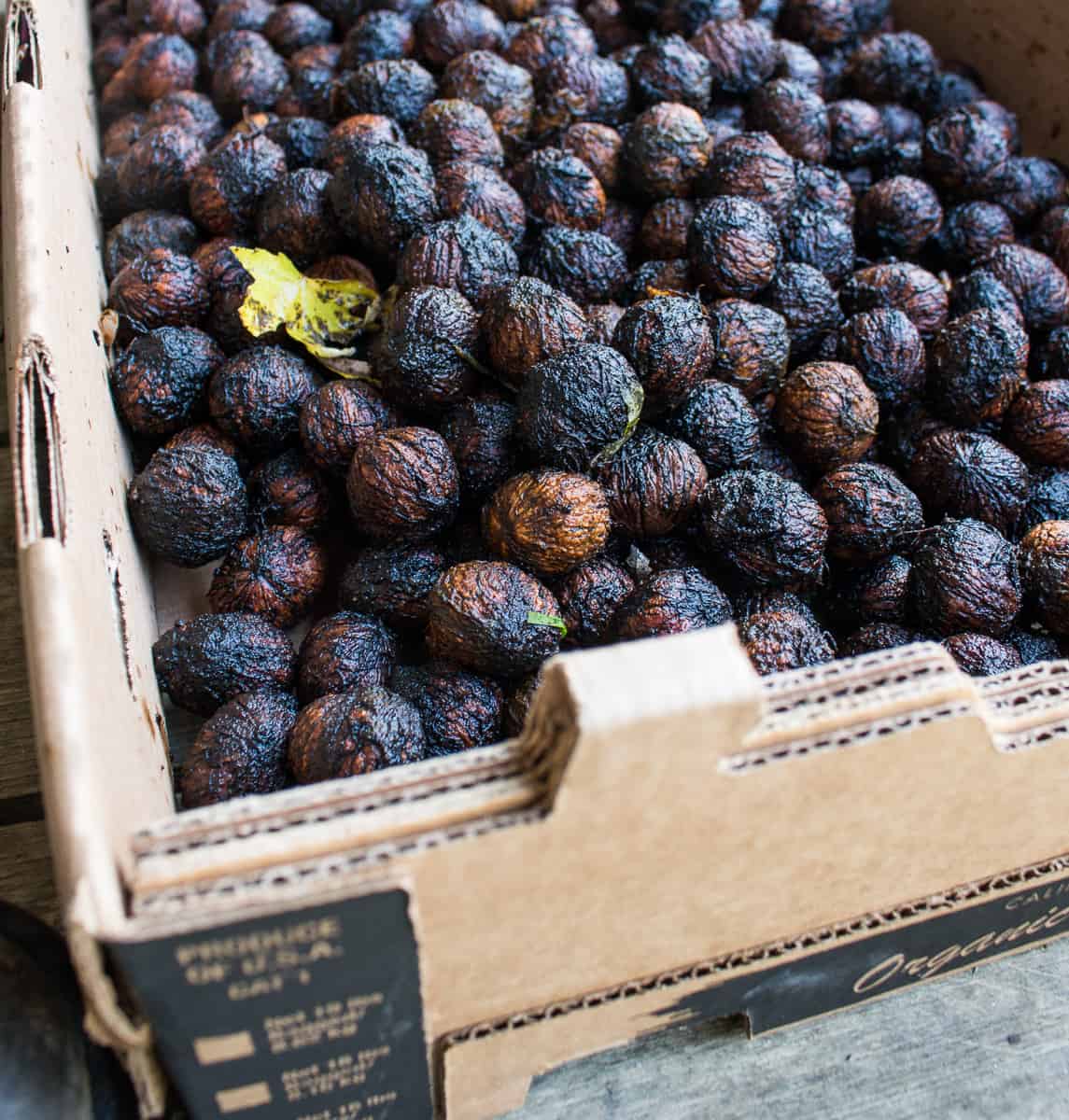
A net bag works, as will laying the nuts out on screens, or in a cardboard box as long as you have a fan or something to move air over them, as even a small amount of water in the bottom of a container can cause the nuts to mold.
The most important thing is that your nuts are bone dry. There's a few ways to dry the nuts I'll go over below.
Box Fan Method
I like to use sheet trays and a fan in my garage, as illustrated below. It typically takes 2-3 weeks for my nuts to dry completely.
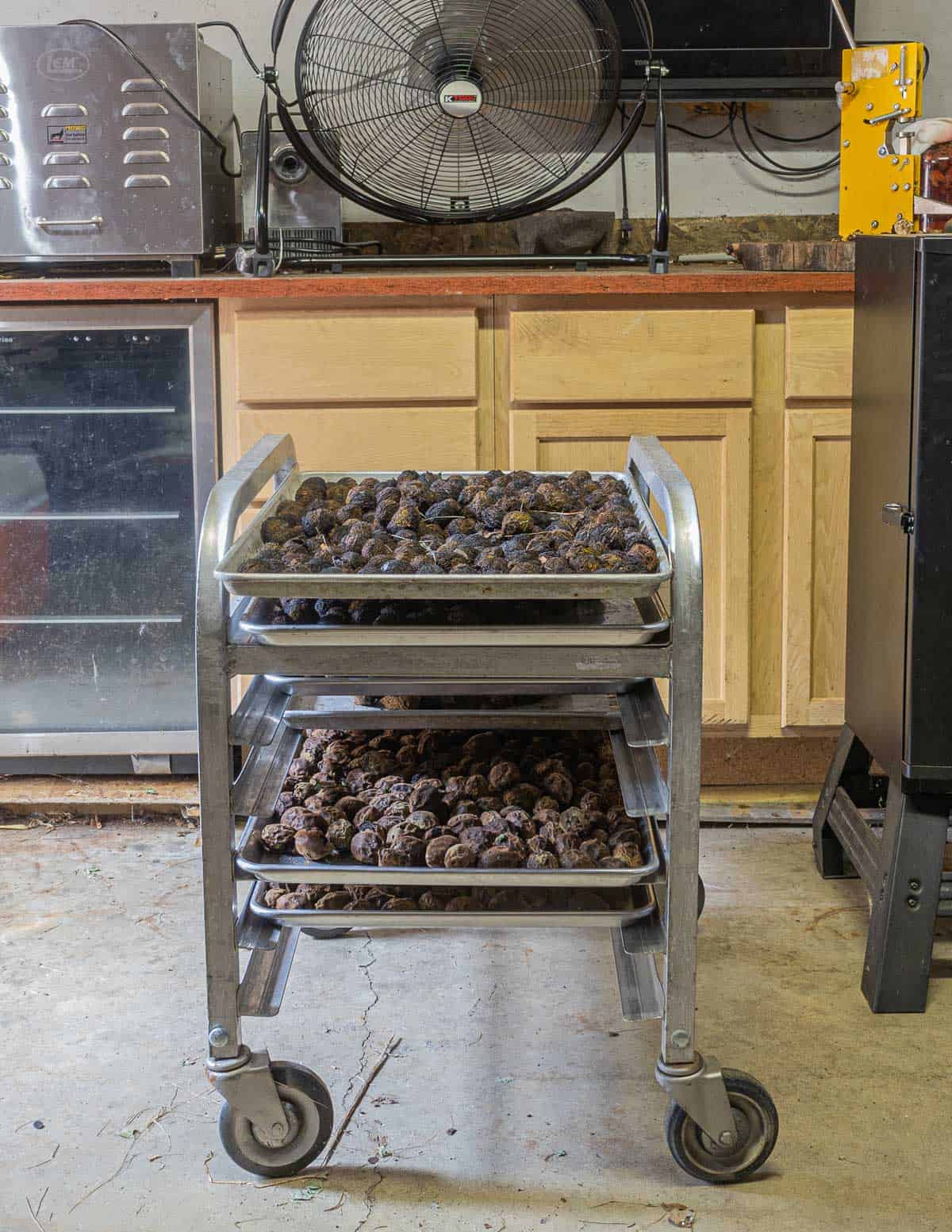
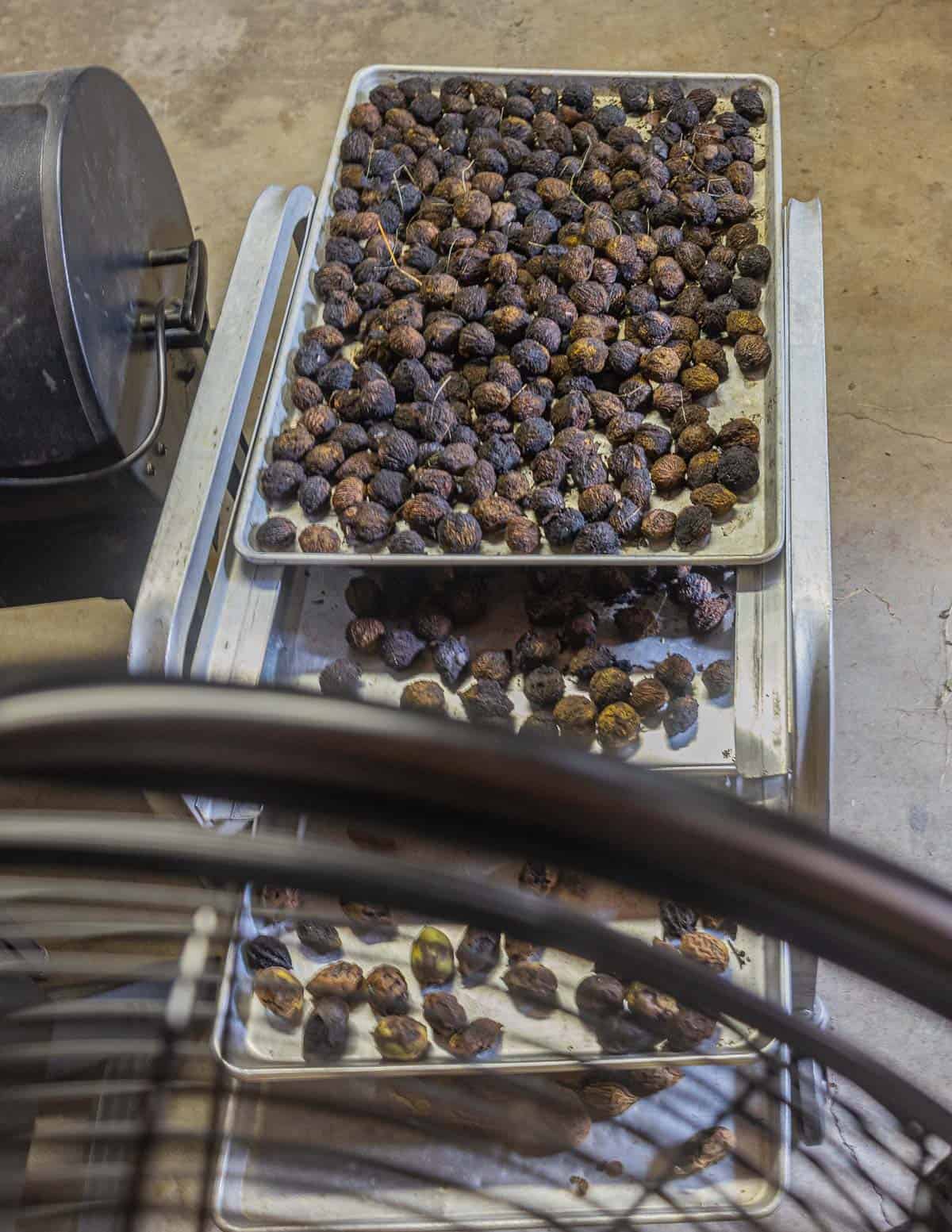
Dehydrator
You can also dry black walnuts in batches in a dehydrator, (use a large square model like Harvest Maid or Excaliber) and it is the fastest way to dry them.
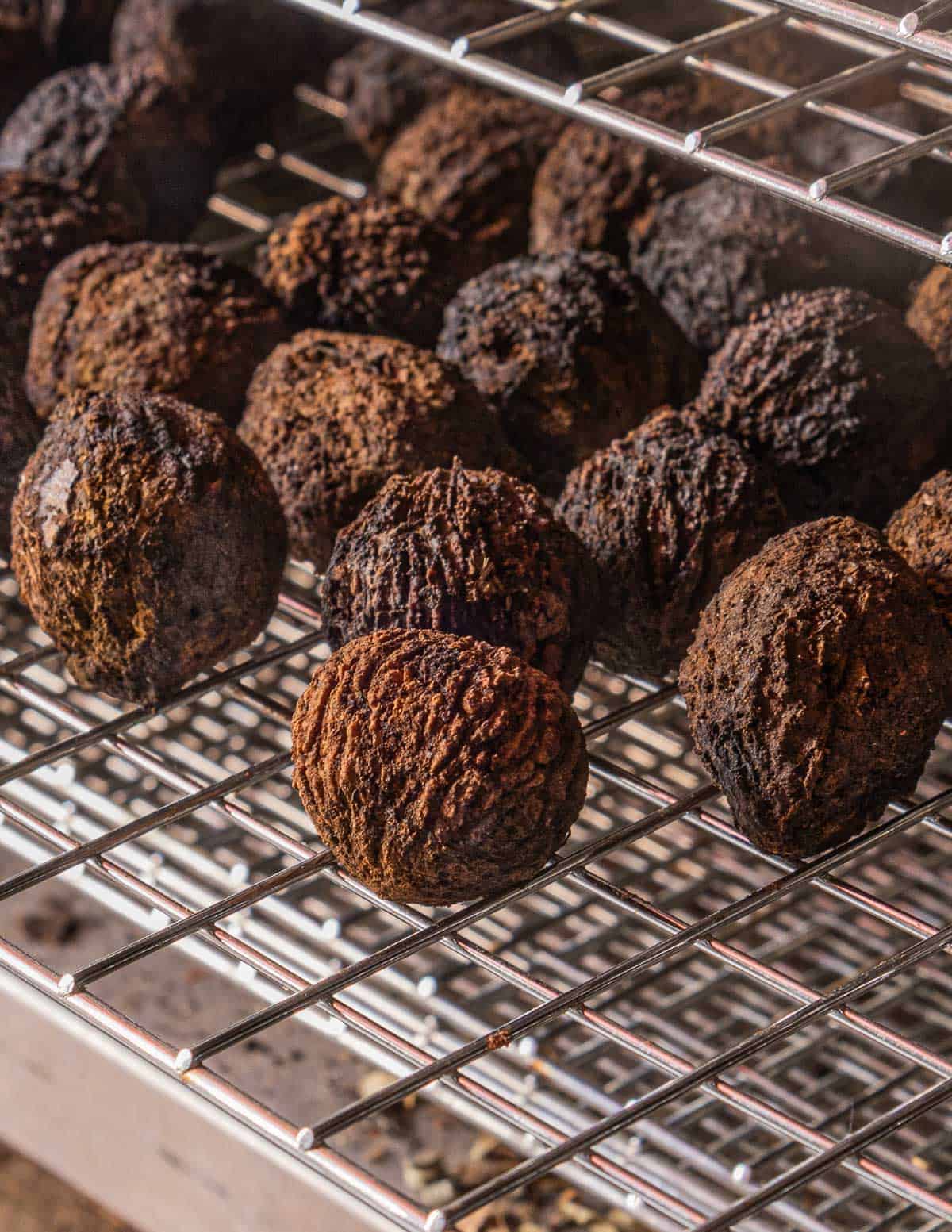
Putting them on cookie sheets in an oven with an adjustable temp around 150 could work too, but I would crack the door to avoid cooking them. Use this as a last resort.
Allow the cleaned nuts to dry and cure for roughly 3 weeks or until they're completely dry. From here, the nuts are shelf stable, and can last for a few years, allowing you to crack and enjoy them as you like.
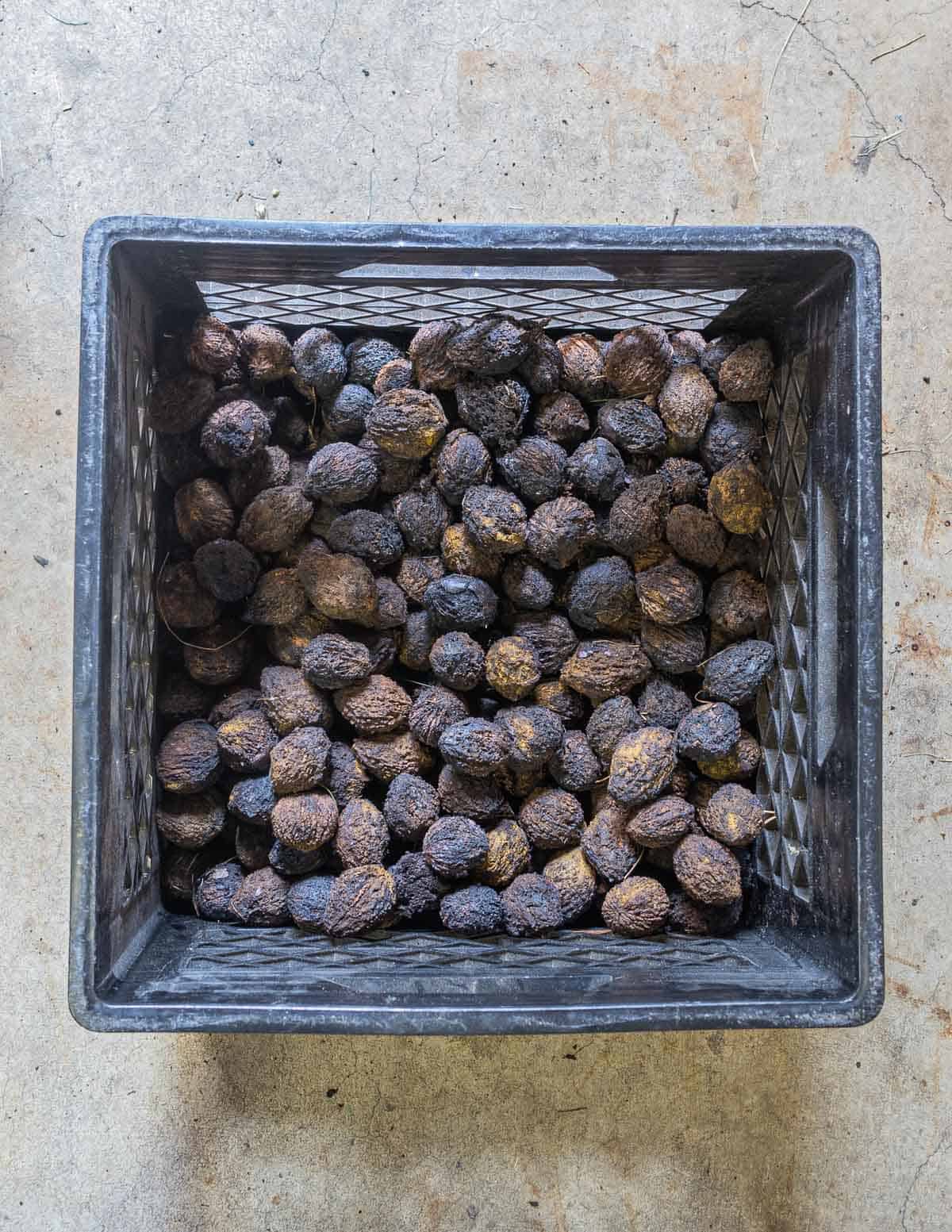
Outsmarting the squirrels
It can be tempting to store the nuts outside after washing, especially if you don't have room to put the nuts on screens, but squirrels are talented nut thieves, and, if you leave the nuts out unattended for even a few days they will find your stash and help themselves.
I learned the hard way when I picked and processed all the black walnuts I could find one year, left them in a box outside, only to find that over the course of a week, the single squirrel that runs around our yard had helped himself to over 2 gallons of nuts.
Cracking
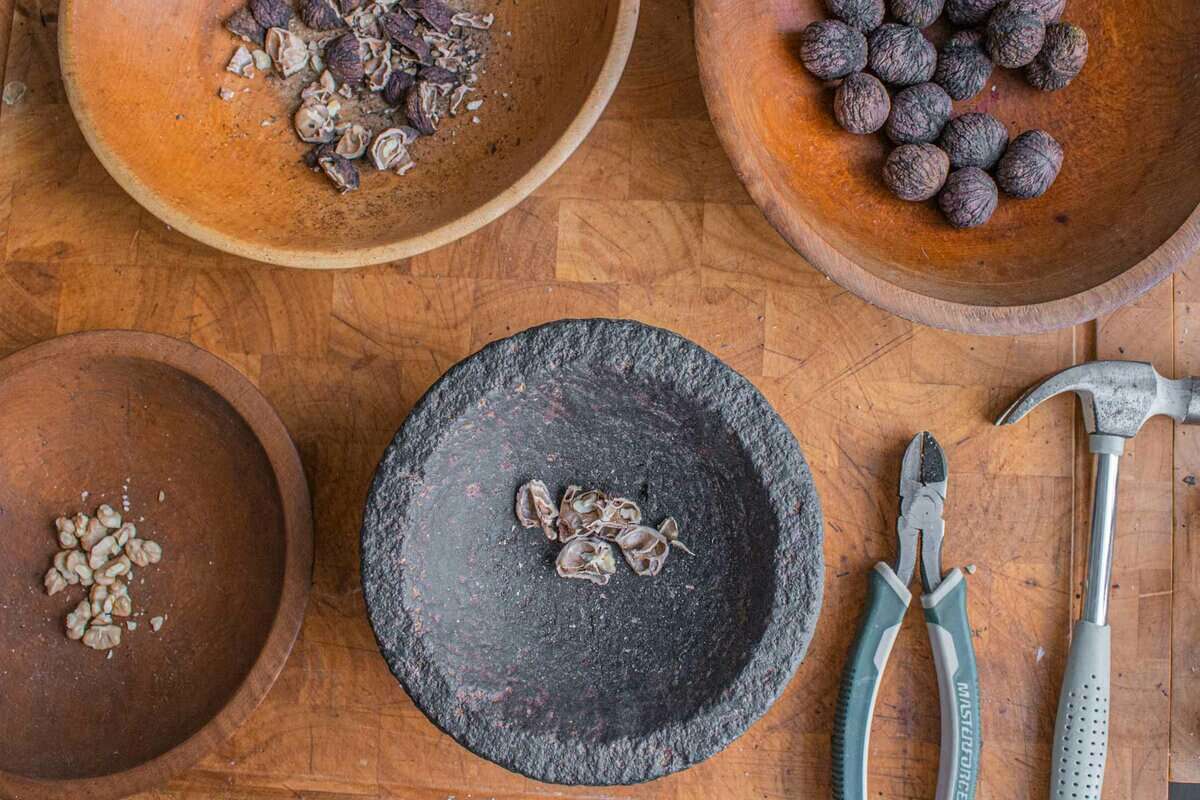
The most difficult part, and why I swore I would never crack my own black walnuts. One taste of a freshly cracked black walnut though and you'll be a believer.
Black walnut shells are amazingly hard--much harder than English walnuts, and you won't be cracking these in a rocking chair with Grandpa for Christmas, rather, you and grandpa need to go to the garage and make a little nut cracking set up. Here's what you'll need.
Workbench or other firm surface
Cracking surface. I use a molacajete here, and I highly recommend it, since it's also the greatest spice grinder you'll ever meet.
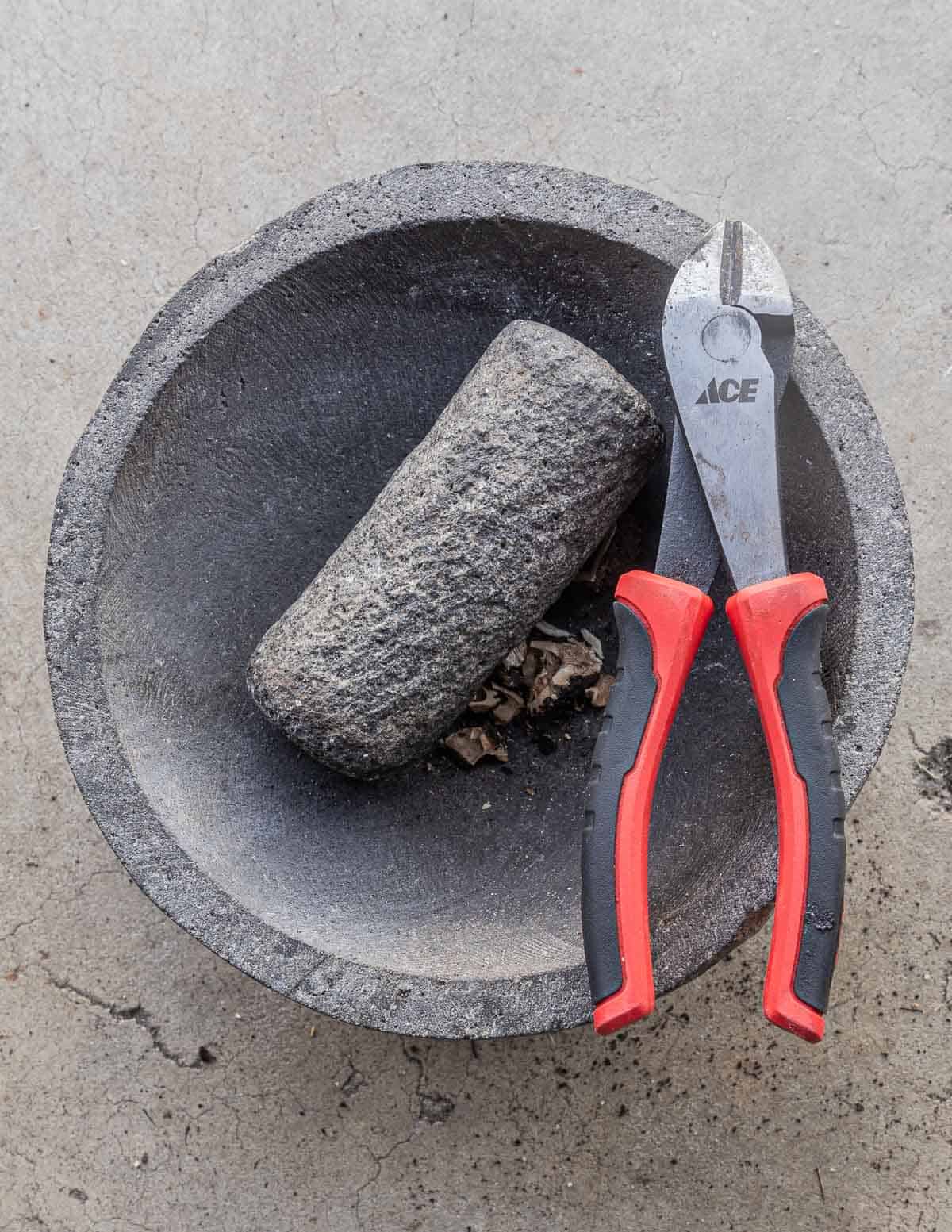
Since they're made from basalt/volcanic rock, they're heavy and hard, and no amount of nut cracking or missed hammer blows will harm them. You can also use a vice.
The secret to getting whole ¼'s: a metal snips
Snips are indispensable and without them, even with a great hammer technique, you will never get the picture perfect nuts you see in my images. The snips are used to spot-treat problem shell parts, releasing the perfect quarters. See my video for a hands-on demo.
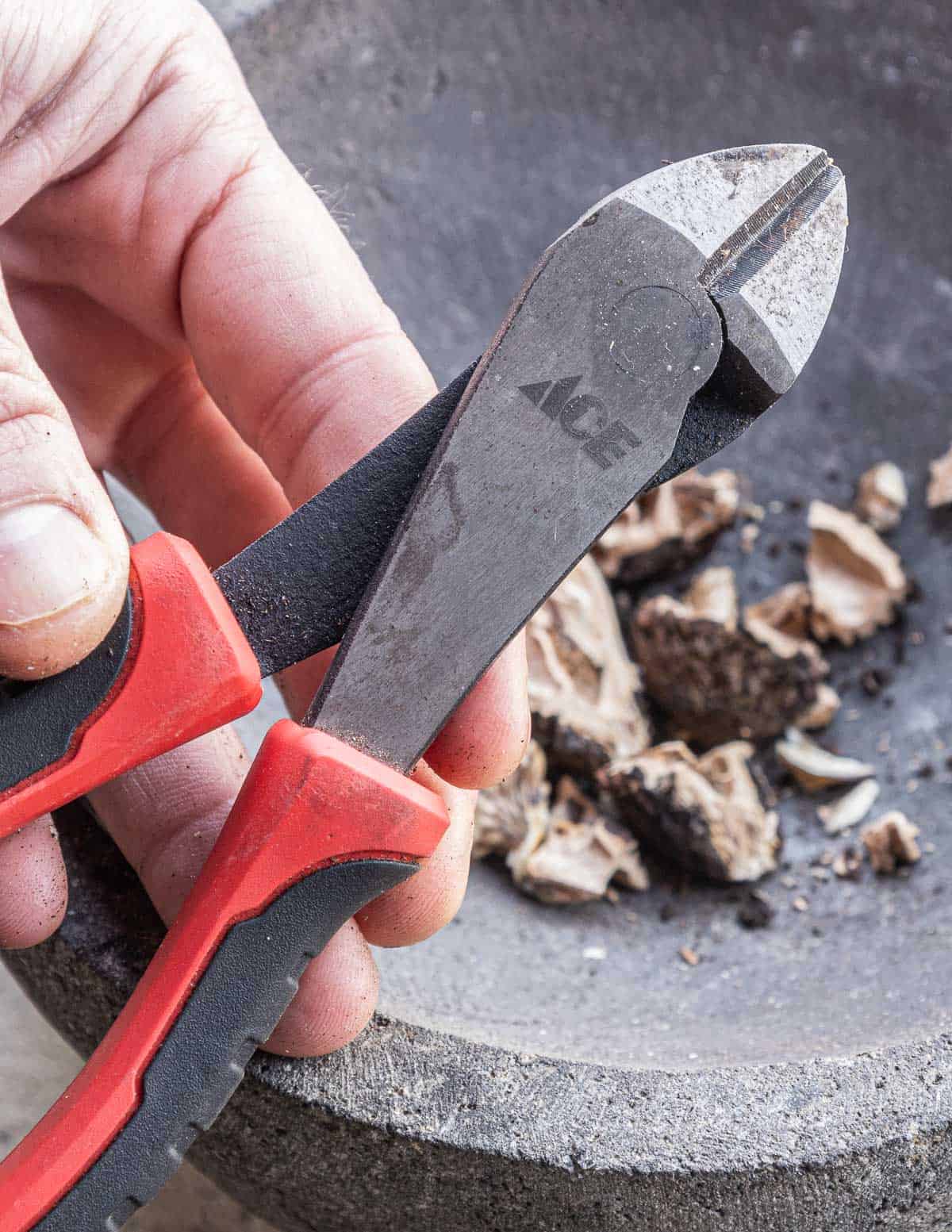
Nut pick, preferably homemade
Conventional nut picks are obtuse, useless tools for black walnuts and other nuts like butternuts and shagbark hickory. They're just too thick, and all they're going to do is crush your precious nutmeats.
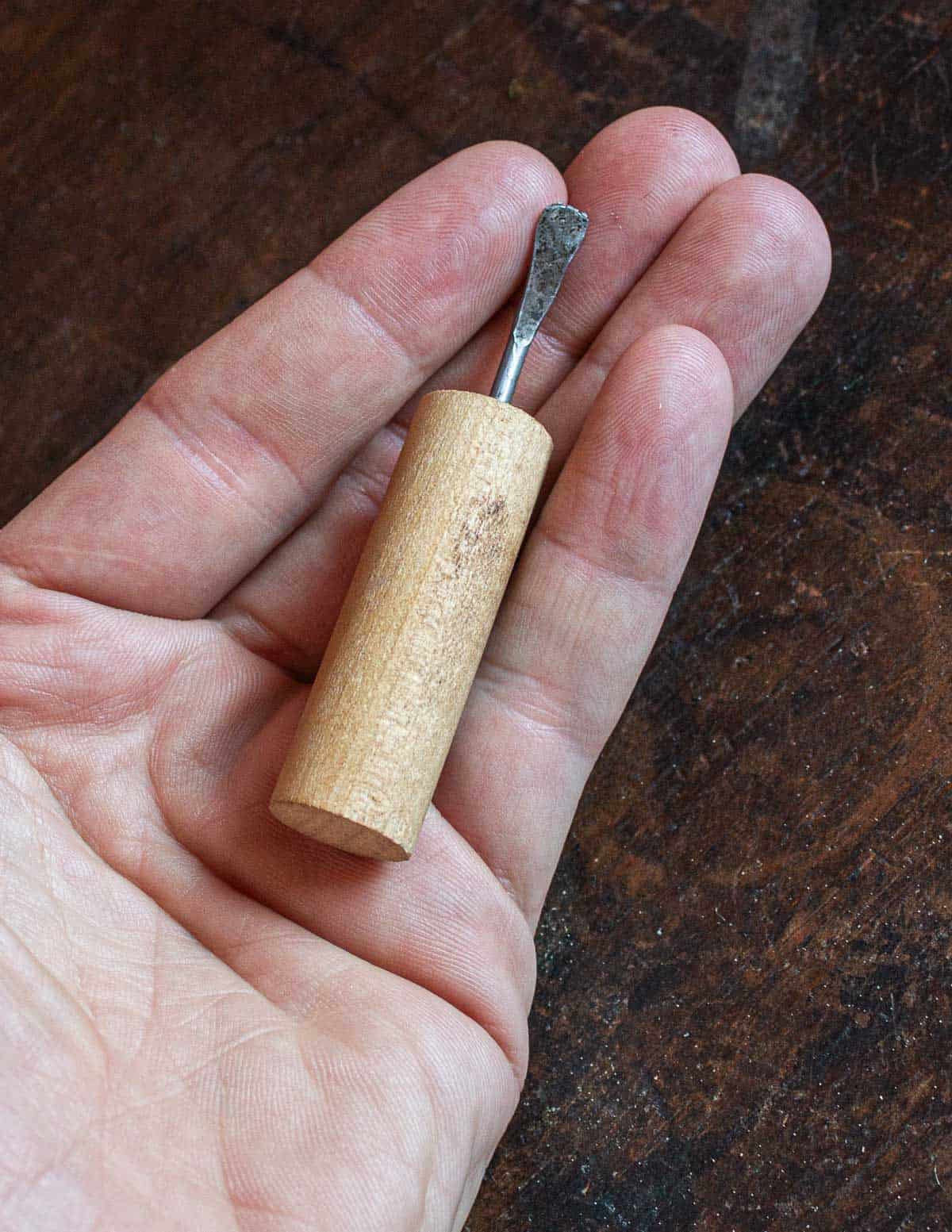
The good part is, it's easy to make a homemade nutpick. Take a dowel, preferably made from birch so it won't split, and cut it into lengths a couple inches long. Pound a nail about halfway into the dowel. Next, pound the head of the nail flat using a hammer--this will be your "pick". Sam Thayer showed me his process of making these, and they're light years beyond conventional nutpicks.
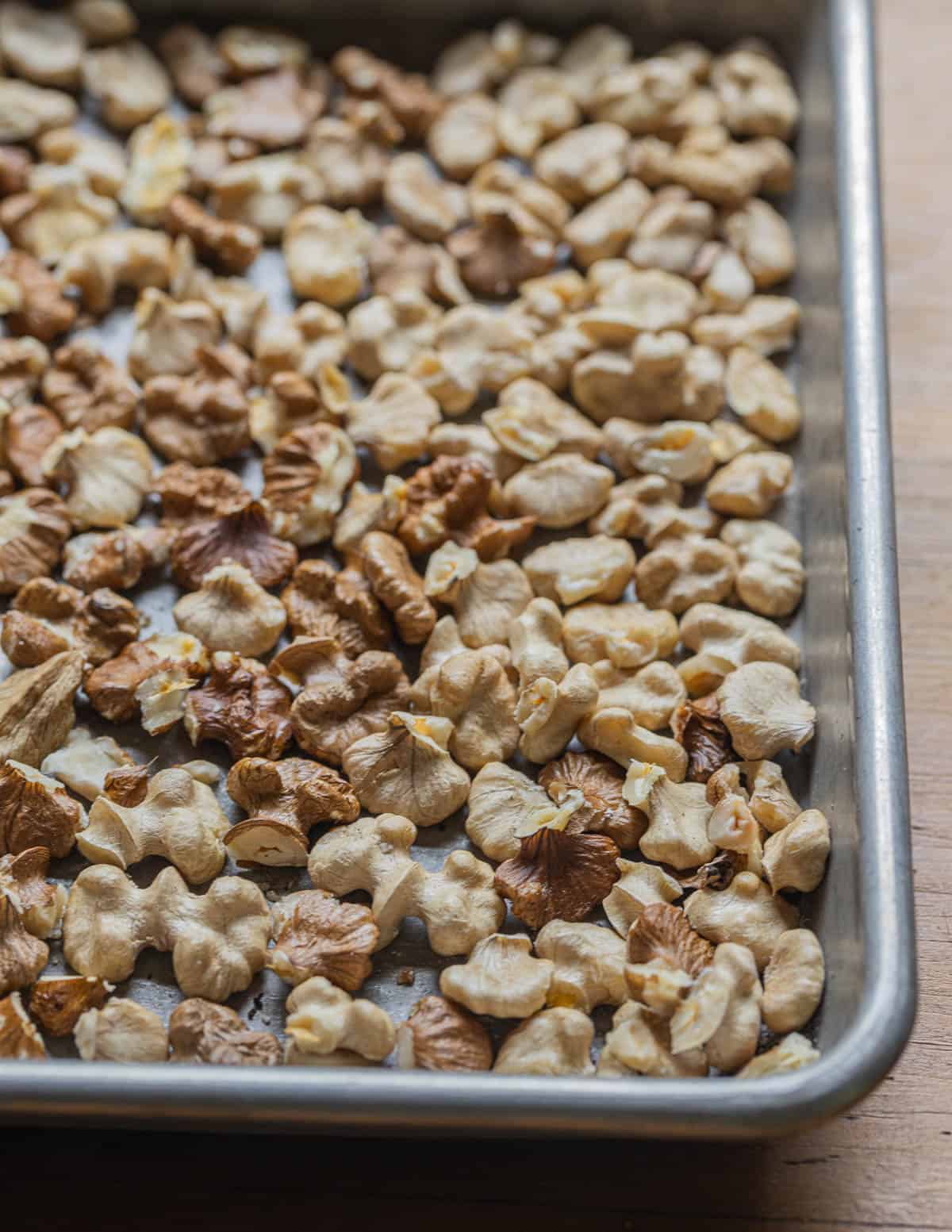
How to crack by hand
Take each nut, and, holding them by the points or seams, give a good crack to the flat portion of the nut just until you hear it crack--don't smash them. Now rotate the nut and give them another crack on the seam (top or bottom).
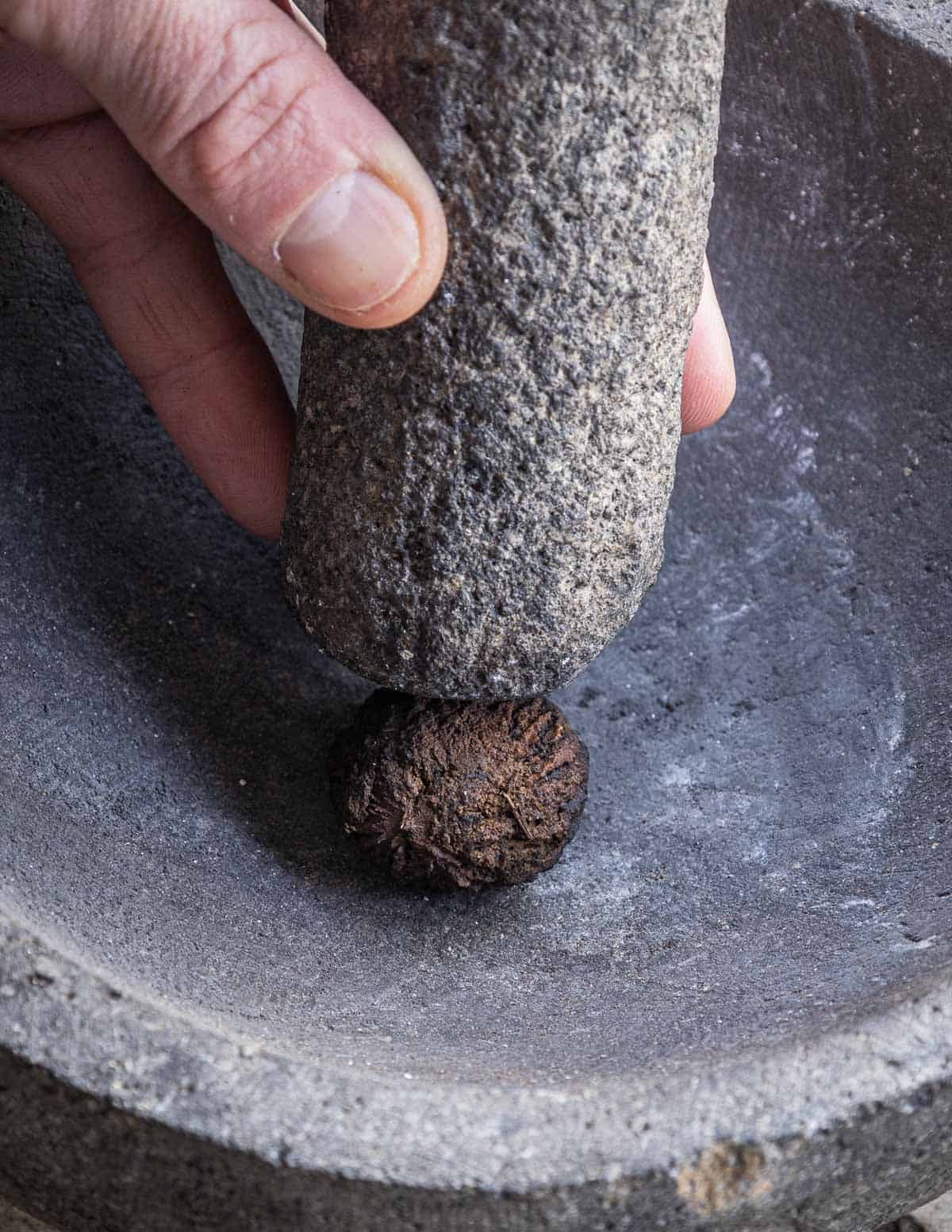
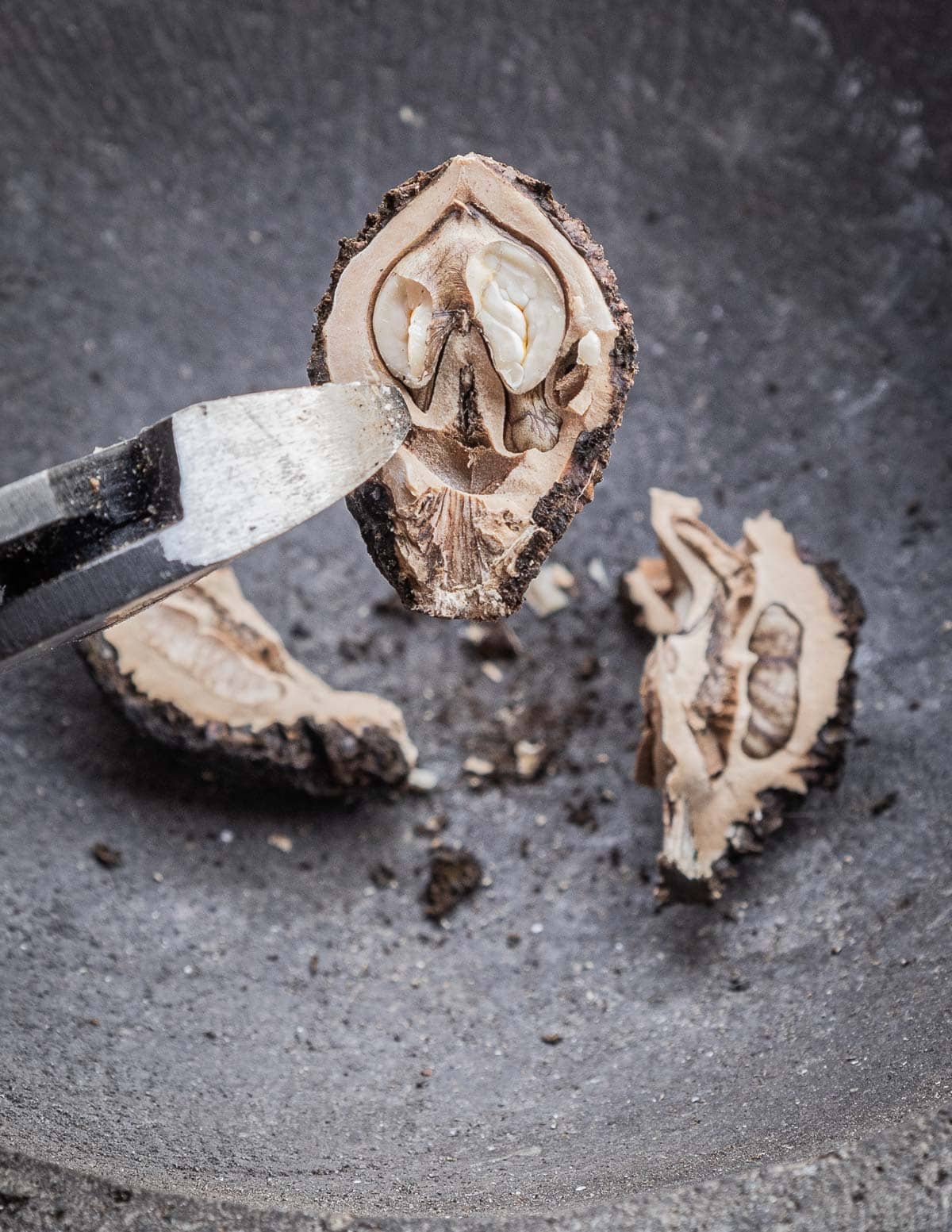
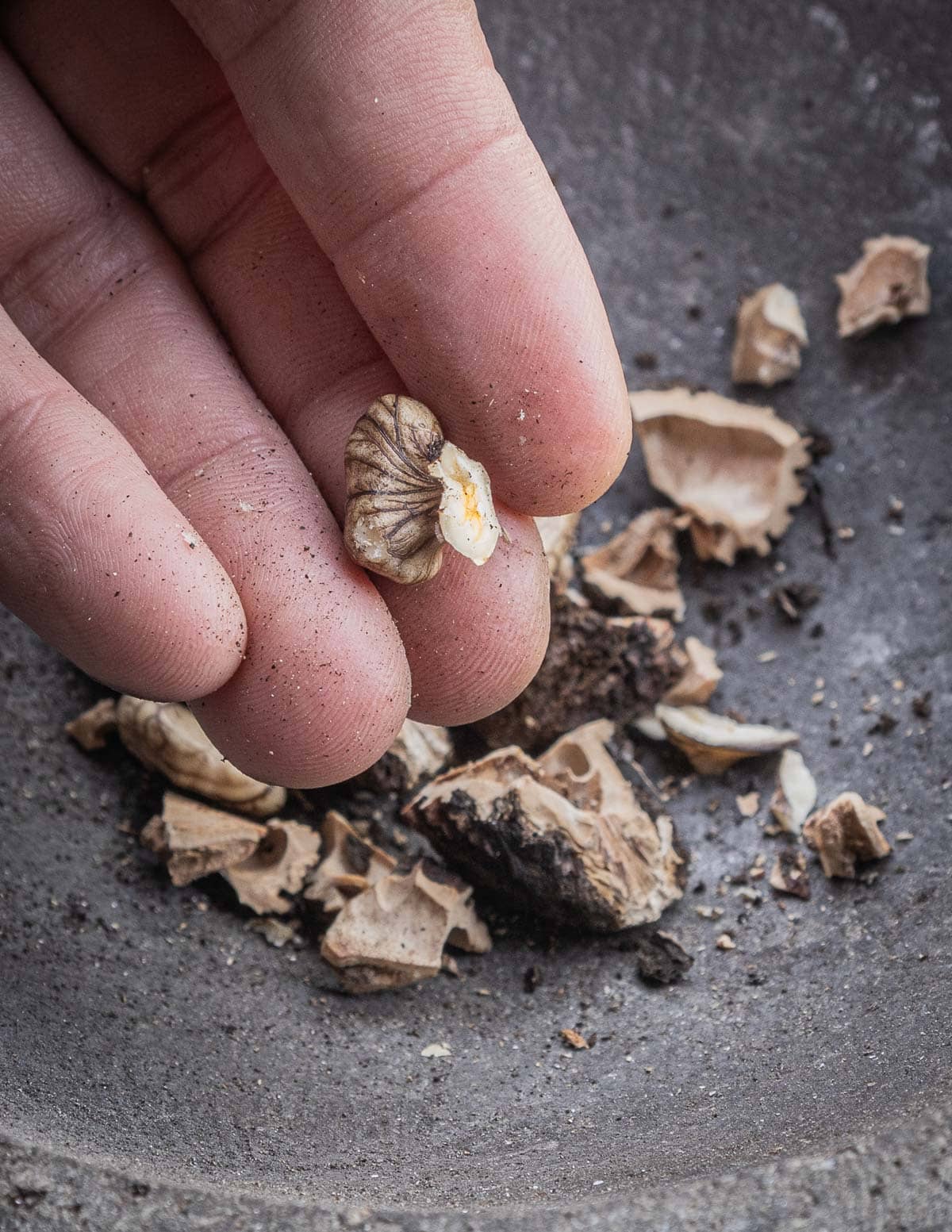
With enough practice you should now have a cracked nut, with 4 whole quarters. Put the nuts in a bowl and continue until you have a large bowl of cracked nuts, then go though each of them, using the snips as needed to free the whole quarters.
After cracking, rinse and dry the nuts to remove any tiny shell particles that can crack teeth.
The best black walnut cracker/sheller
There's a few products on the market that make things easier, but one of them stands above the rest. The Grandpa's Goody Getter is by far the easiest, most efficient black walnut cracker I've ever used. It's an investment, but it's worth it.
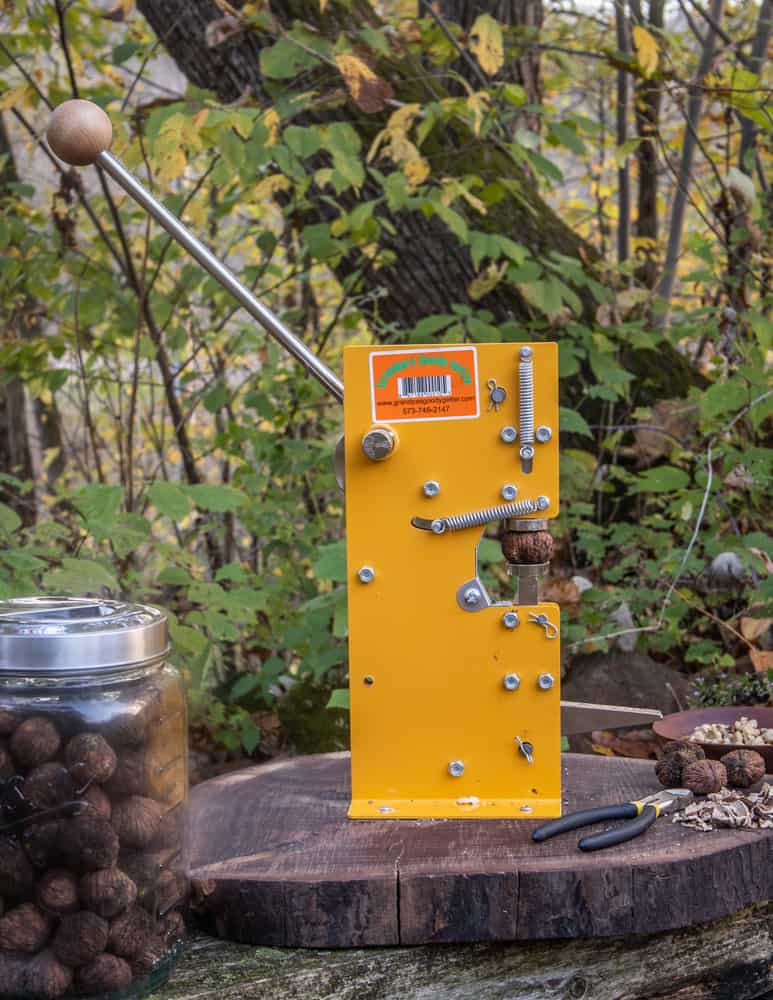
Cooking
To me, black walnuts are really the Rolls Royce of nuts, and there's nothing like a freshly cracked black walnut with it's unique scent and curious aroma. The flavor is incredibly strong, and keeps throughout cooking in whatever you make, bread and baked goods like cookies and cakes, or just sprinkled over granola or yogurt.
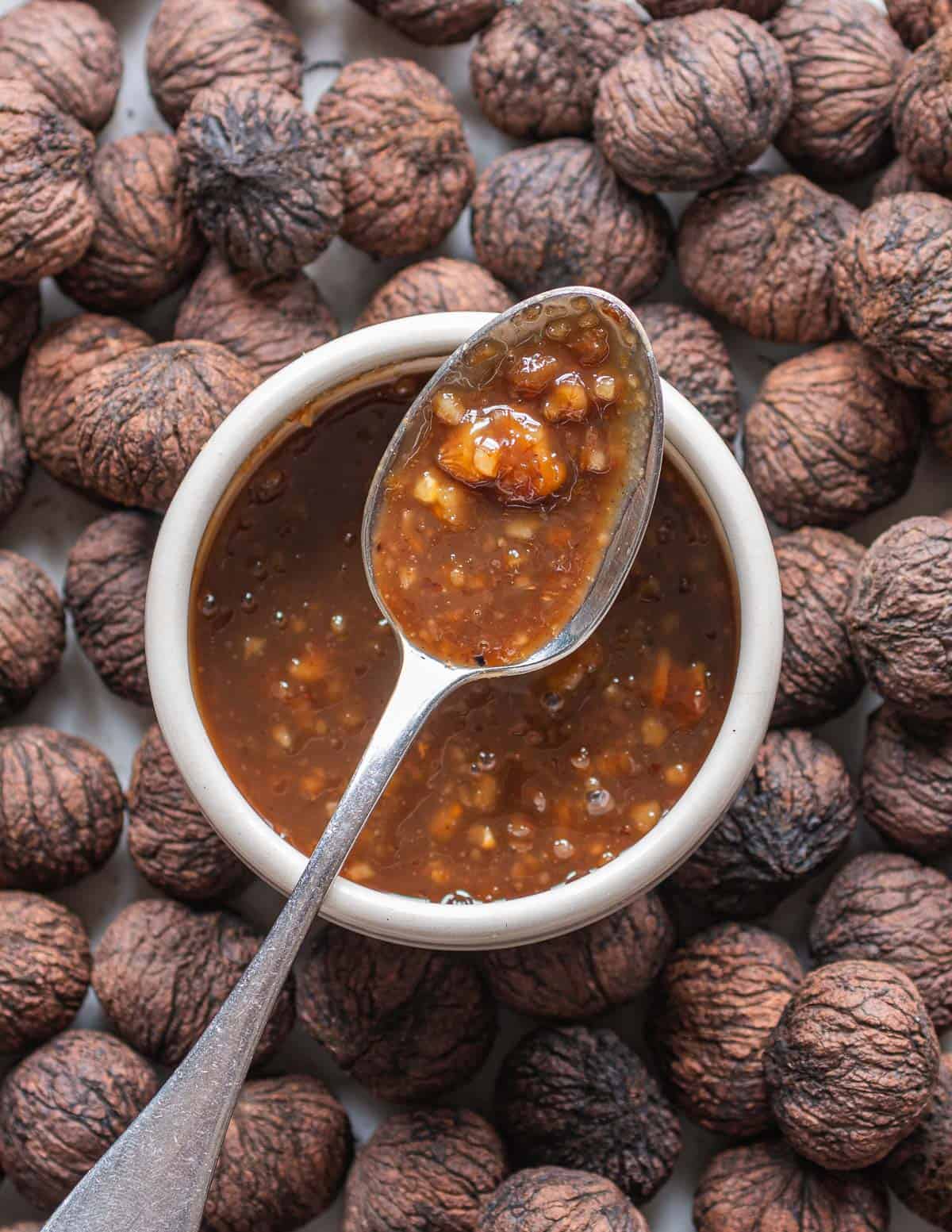
Since you just went through a lot of work to get all those perfect halves, I think it's good to leave them in large pieces, generally. One of the purest ways to enjoy black walnuts is to simply sprinkle them on things. Ice cream is pretty epic too.
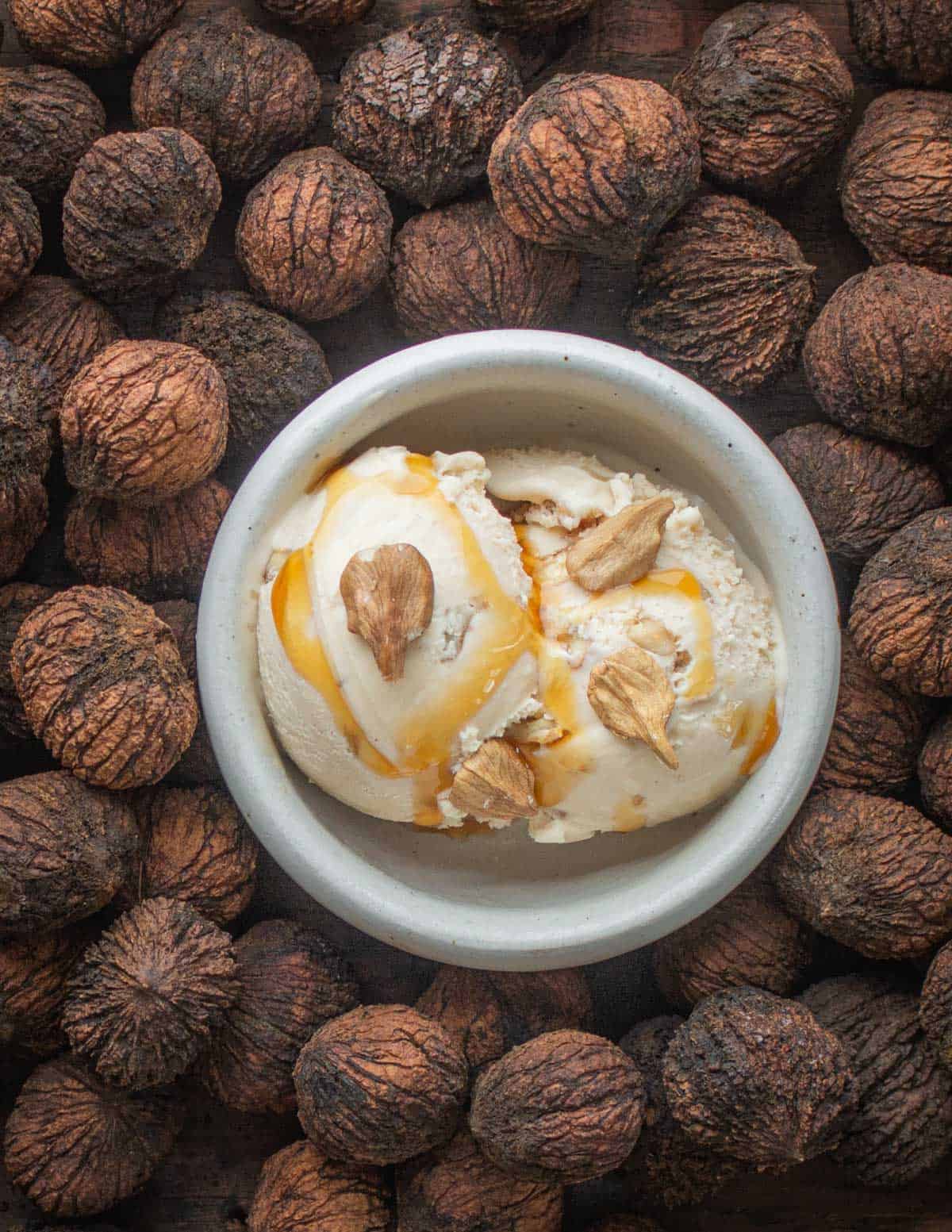
More Recipes with Black Walnuts
Additional Information
Do fresh nuts need to be toasted?
Once the nuts are shelled, the perfume and aroma is at its peak and there's no need to toast the nuts, contrary to what I drilled into my line cooks for years.
But, as nuts sit in on a shelf the flavor diminishes and, after a month or two, a gentle toasting will revive them a bit. I always toast nuts that've been stored or frozen.
Rancid nuts
Black walnuts are widely known for their tendency to go rancid stored at room temperature. How do you know if the nuts are rancid? If you eat it and it tastes terrible, like mold, it's rancid.
Always store black walnuts in the fridge after cracking. For long-term storage, vacuum seal them and freeze.
Yellow streaking
Once I started cracking black walnuts from trees in Wisconsin, I noticed that some had yellow streaks. Terrified of the nuts being rancid, I threw plenty of them out. That was a mistake. Referring back to rancid nuts, if your black walnuts are rancid, you will definitely know.
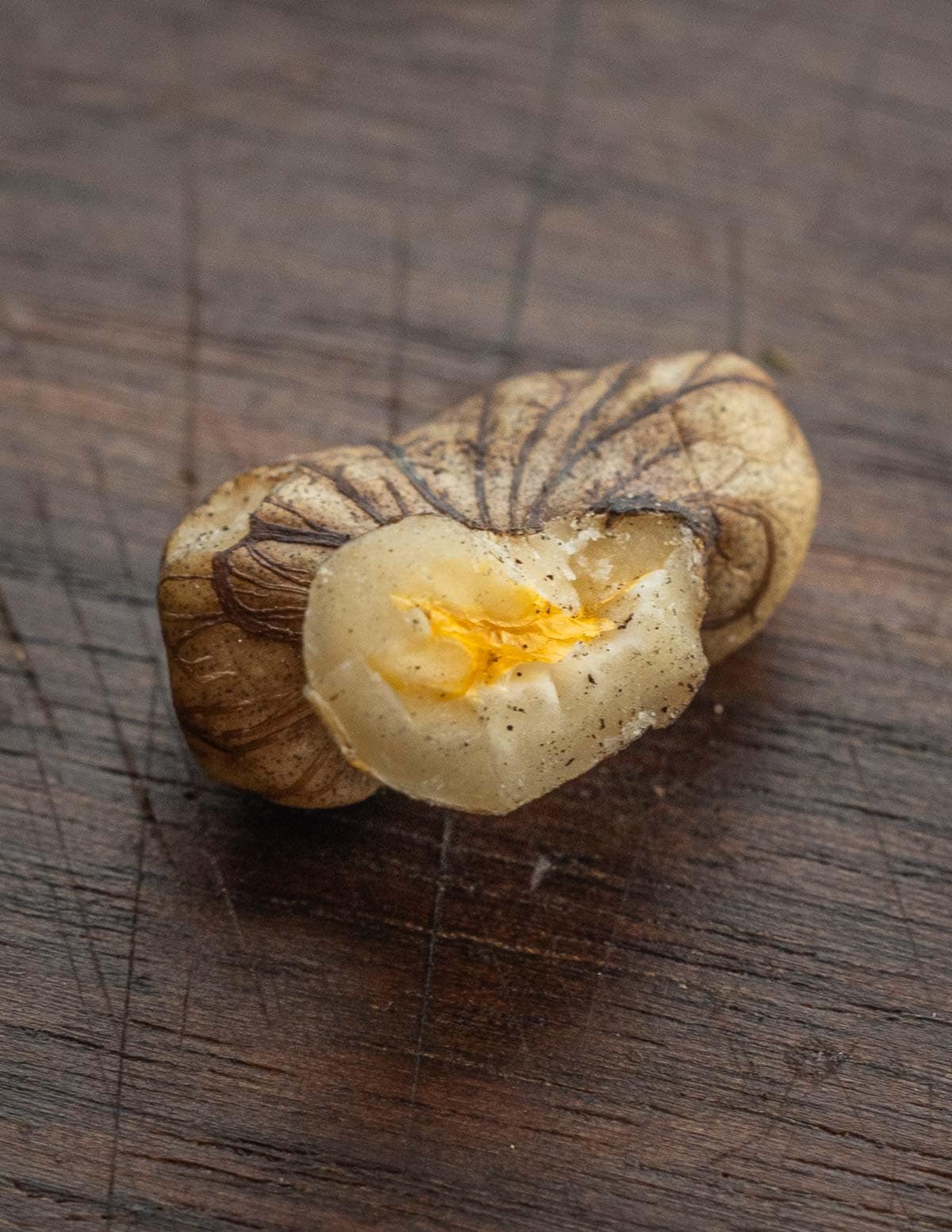
As far as I can tell, the yellow streaking is a harmless anomaly (Sam Thayer said it might be related to temperature) but, if you know the science behind yellow streaking in black walnuts, let me know. Rest assured, I've eaten plenty of nuts with yellow streaks, and they're just as delicious as other black walnuts.
Uses for cracked nut shells and scrap
After you've cracked some black walnuts, you'll have plenty of shelled nuts, and probably a few with small pieces of nut meat left inside. I save all my nut cracking scrap in a box in the garage, then I make piles of the spent nuts on a rock in the backyard.
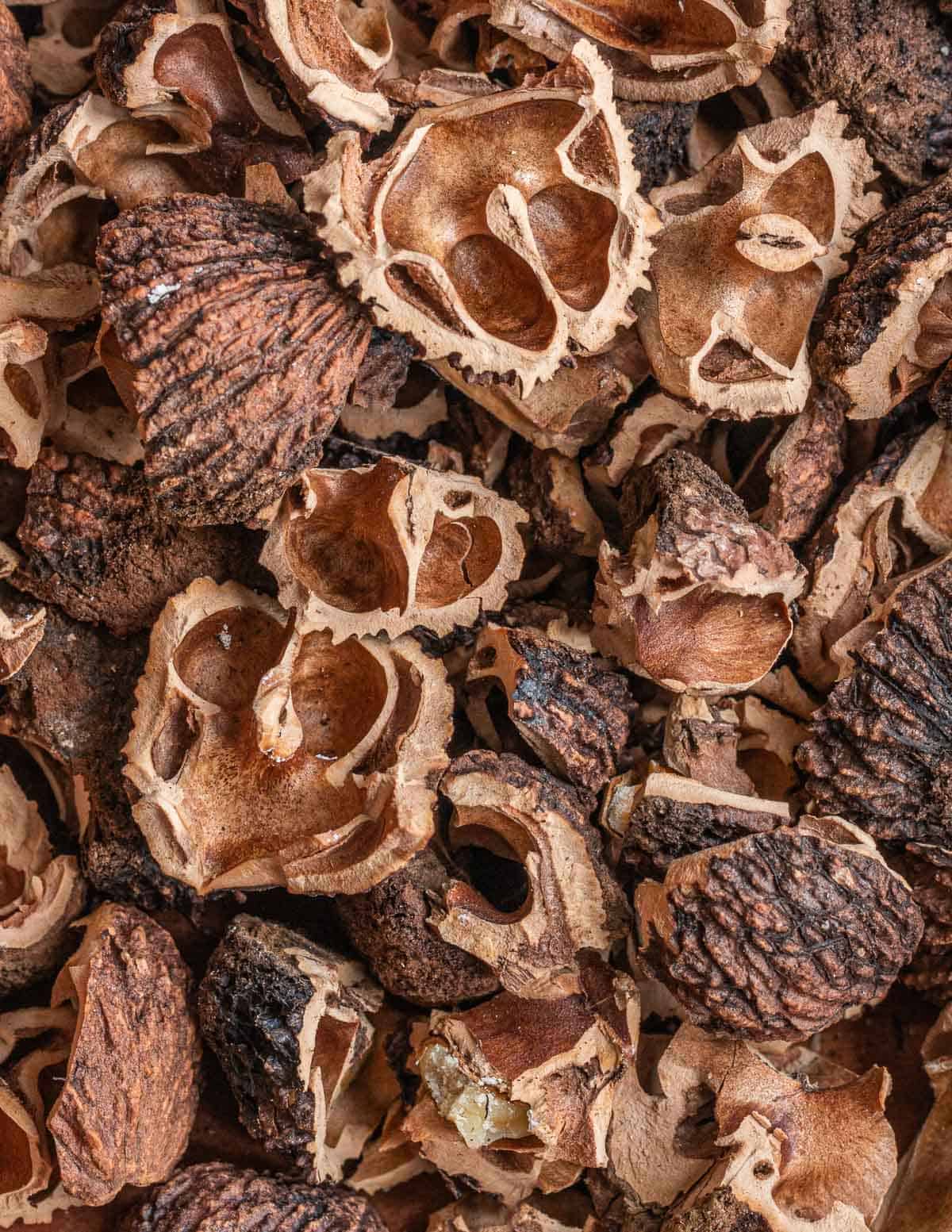
Every morning I get to witness the birds and squirrels who come to feast on the nuts left in the shells—it's a great way to share your harvest!
Squirrel bait
We know squirrels love to steal black walnuts. If you like to eat squirrel occasionally as I do, know that spent black walnut hulls and shells make some of the best squirrel bait you can find. Put some spent nut shells in a trap and watch them come.
Green, unripe walnuts
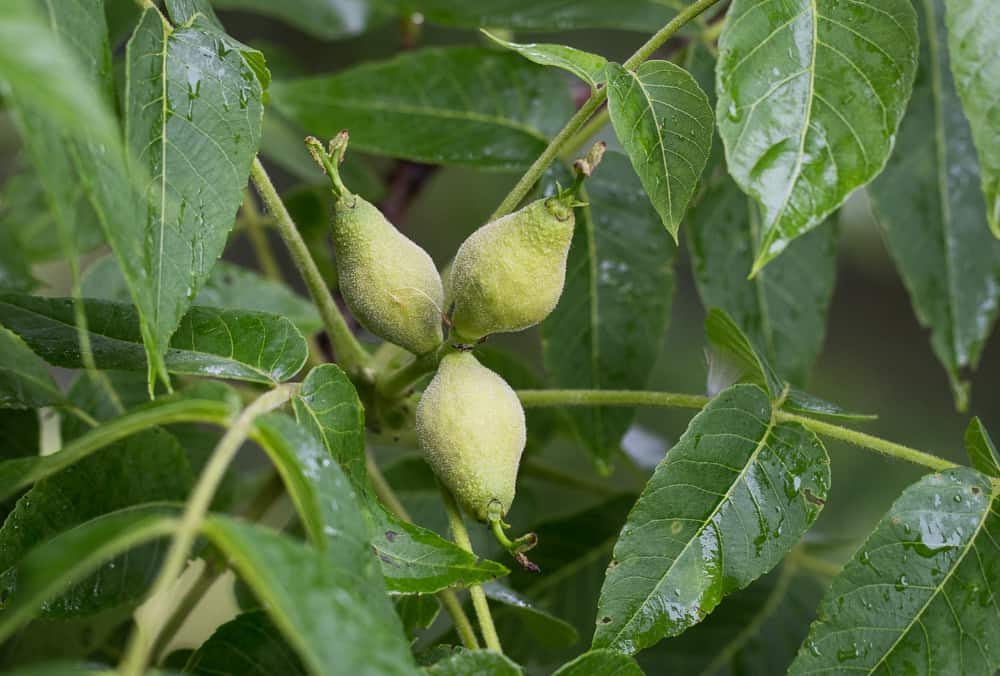
Black walnuts, and other walnuts, give us a lot more than just nuts and oil. The green, meristematic nuts have long been used for making edible products and things from condiments to preserves and liquors.
Green walnuts are outside the scope of this post, but I do harvest plenty of them, typically in June in Minnesota and Wisconsin. You want them about the size of a ping-pong ball, or sometimes smaller, depending on the recipe you're preparing.
If a knife or pin can't be stuck through the young black walnut, it's too old, but can still be used to make nocino. Unripe black walnut leaves are also harvested to make different things, most notably black walnut bay sauce, a sort of vinegar infusion.

Butternuts: the white walnut or juglans cinerea

Butternuts are similar to black walnuts, but also very different, so different that I'll write about them in a separate post. For our purposes here, know that if you find some butternut trees, you're lucky, since they suffer from butternut canker, and they're numbers are dwindling.
In Minnesota, they're listed as an endangered species. The flavor of the nuts is nothing like black walnuts. Butternuts are fresh, buttery, and without any sort of tannins like English walnuts. They're delicious, but more difficult to find than black walnuts.
How to Harvest and Store Black Walnuts
Equipment
- Large plastic tub
- Boots
- Gloves
- Gunny sack or boxes for storing/drying
Ingredients
- Waterproof gloves
- 5 gallon bucket or another container
- Drying racks or milk crates
Instructions
Harvest the nuts
- Harvest the nuts in late fall, using the heel of your boot to remove the green hull. Pick the nuts up with gloves as they stain.
- For large batches, you can put the nuts in a 5 gallon bucket, cover them with water and stir with a paint or mortar mixer drill attachment to remove the hulls.
Washing
- Wash the nuts until the water runs clear
Drying
- When the nuts are clean, lay them out to dry, without putting them in a large pile, in a ventilated area. They'll dry up to twice as fast with a fan blowing on them. A garage works great.
Storing
- Once the nuts are dried, they can be stored for years for use as a food. You can test a walnut to see if it's done by cracking some, the nut meats should be loose in the shell. Freezing black walnuts after cracking.


ken deats
We used to throw the brown walnut husks onto the driveway and when the car drove over them, it would leave the walnuts. We would dry and then crack them with a hammer onto a little anvil.
Alan Bergo
Hey Ken, yes, plenty of folks still use that method. Thanks for commenting.
Danny
I started collecting black walnuts last year and am getting some now. I start a fire in my fire pit, boil the them in water for 10 minutes. After they cool the shells come off easy, even the green ones. I then wash them and sun dry (away from squirrels because I have been robbed.) I’ve found that boiling them reduces the pungent flavor and have had people who do not like them, say they’re more tolerable. It works for me, because I spent most of my years despising them, and now I don’t. Maybe I’ve just acquired a taste fir them now. 😊
Alan Bergo
Hey if it works for you, that's great. Keep spreading the walnut love.
Corbin
I took the advice of other sources before finding yours and attempted to dry some of my clean walnuts in the sun for a couple of days. I've noticed that most of not all of the shells now have cracks in them. Do you think I should avoid the sun or perhaps it was a combination of soaking too long in water and high temps from direct sunlight?
Alan Bergo
Soaking in water, from my experience can potentially ruin the finished nut. I have never had that happen before. I don't see anything wrong with sundrying them, just make sure the squirrels can't get to them.
Patton Bybee
I live in Tennessee and love black walnuts. I bought a hand operated corn sheller and hull them green, works great. I also made a tumbler to get rid of dried hull. This really helps in cleaning walnuts.
Alan Bergo
That's great Patton. I've heard of lots of different ways people have figured out to clean them.
Pete
Too bad I didn't see your article til today. The squirrels devoured our whole bag!
Alan Bergo
It's happened to me. They just love them.
Glen Isner
I've cracked a lot of nuts and experience has taught me that if you are picking little pieces out of shells you are wasting your time and degrading your product with shells. Take the larger pieces and discard the rest. It's quicker to crack another nut than to pick for a crumb.
Alan Bergo
I agree. I get almost exclusively whole quarters now, especially since I started getting grandpas goodie getter.
John
If you can't stick a pin through them then wouldn't they be too young, you wrote too old. Thanks! Got a box full of them and wanted to make sure I wasn't allowed to roast them to get the shell off. Glad I read this post.
j.c. brooke
once the nuts are washed and dried, (still in the shell) can they be stored in below freezing temps through the winter? i live in northern michigan and do not have a heated pole barn.
Alan Bergo
Hmmm, that's a good question. As nuts can be frozen just fine, and it actually works well for preserving the quality and oils of freshly cracked ones, I would assume so, but the devil in the details could be repeated thawing and freezing in the spring. I am speculating here as I always keep mine in a non-frozen place.
Chuck Walker
Back in the 60's we collected about 1000 black walnuts each fall. Our method for processing was to spread the green nuts in a single layer on the basement floor and let them dry all the way to the nut, with the outer shell turning black and crispy. We turned them 2 or 3 times. At this point you could walk the husks off or hit them with a 1" steel pipe elbow on a short piece of straight pipe. To crack the nuts to get larger pieces we found it best to use a vice, turning the nut once - much greater control over the cracking process and easier to pick afterwards..
Alan Bergo
When the hulls are allowed to decompose naturally, connected to the shells, it compromises some of the flavor. Hammons (the largest producer of black walnuts in the world (30 million pounds net last year) encourages all harvesters to harvest the nuts as soon as possible so they may be hulled to keep the best flavor.
john
I tell you what, I had plenty that weren't gone black, and I took to the green ones with a pairing knife and medical gloves until my hands went off. Can't imagine the machine they use to harvest the unblackened ones.
Steven
Was just wondering a couple things.
1 When you put the nuts in a bucket of water, some float, why, and also the meats can be different then other meats, are they fine to eat.
2 Some of the meats inside the nuts will shrink and turn dark or black and taste different, are they safe to eat.
Alan Bergo
Nuts that float are likely hollow or aborted-discard them. Overly shrunken or discolored nuts should not be consumed.
Lynda B
We have many old black walnut trees on our property. I have opened some perfectly formed and meaty black walnuts and found them to have no aroma and not much taste. Trees are over 50 yrs old. Any idea what that is about? Fresh off the tree a few weeks ago, little fruit fly larvae ate away the hulls, meat is the right texture, etc., but they are very large nuts. Can they grow too large and get a diluted flavor (like what can happen to some fruits)?
Alan Bergo
I haven’t heard of that, thanks for commenting. There should be some variation between trees, but a lack of flavor in black walnuts would be new to me.
John Otto Stoll
I have hundreds if not thousands of northern Michigan black walnuts. Does anyone want them?
Alan Bergo
This is not a site for exchanging goods
JW
I'm curing a large batch of black walnuts now, and there is a few with light white fuzz on part of the shell. (mold?) I read somewhere that this means I have to throw out the whole batch... Tell me this isn't so! The walnuts look fine otherwise, and seem to be drying well.
Alan Bergo
You don't have to throw out the whole batch, but it makes me think they didn't dry fast enough. If they taste foul after curing you will know.
David Britton
My Dad used a brace-and-bit to drill an exact diameter holes in a wooden board through which he would then drive harvested walnuts to knock off much of the husk. Then the shelled remainders air-dried very well for cracking. Tempting exposure in the garage for mice who love 'em as much as squirrels do, for a good number disappeared into the "secret stash" which I only discovered in late November's hunting season to be my nearby boots stuffed full. Rascals.
MikeR
After hulling, walnuts dried and kept in net bag for a few weeks. Now when I shell them, at least half of them have dried out meat in them. Did I do something wrong? Used power washer in garbage can to wash off the hull debris. I had removed the floaters, then dried them out on floor with a fan for a day or so.
Alan Bergo
Hey Mike. From what I know, you didn't do anything wrong. For whatever reason the nuts didn't form correctly, the tree rejected them, etc. Sometimes I've had this happen with black walnuts that drop very early, which means that the tree rejected them or is having stress or some other issue. My advice is to move around to different trees and collect a mixture of nuts. Once you find a good tree, it will be a gold mine. Let me know how they work out for you.
scott
I experienced the same issue with the dehydrated any useless meat.With hundreds of nuts to crack I did a little experiment and did the float test on all of my remaining nuts. Only 100 out of 1000 sank. Of those 100 that I cracked open all had well developed meat ready to eat. So I did a little more cracking with the other 900 and only about one in 20-30 were any good. lesson learned. These were all off of two trees. I have to believe someone out there can tell us some detail about what is happening. Do they sit too long on the ground? I wonder if there is some optimal time to pick them up after they fall off the tree. First time in the black walnut harvest I need it to be more successful next year. thanks.
Alan Bergo
Scott, I'm not an expert on tree rejection here, but that has to be part of the problem. Sometimes trees reject nuts for some reason, this year we had a cold snap in the spring that I suspect decimated the black walnut harvest. I was only able to gather about 100 pounds of them, when I should've been able to get far more. This year, my favorite tree did the same thing that happened to you, albeit in a smaller quantity since it wasn't masting (producing lots of nuts). I noticed the nuts fell a bit early on that tree, so the early drop has to be part of how you can root that out. It is frustrating. When I get a chance to ask one of my friends whose an expert about why the trees reject nuts I'll try and circle back here.
Timothy
Most common cause of shriveled nut meat here in Kentucky is - in my experience - lack of sufficient water during nut formation... a dry spell. Best practice is to crack a handful of nut from a tree before spending time gathering from it; can save a lot of grief.
Alan Bergo
Thanks Timothy
roy roland
when i picked them fresh off the ground i crack some from different location and most have yellow streak or spots in the meats this started last year but this isnt the normal color of black walnut meats you daid these are still good to eat is this still true
Alan Bergo
They're fine to eat yes.
NavyDave
The black walnut trees in my yard and and along the bike trail here in Bowie, Md have matured early so I have been taking zip lock bag fulls to Walter Reed to give to people who work at the appointment desks and NEX. I use and old school mini flathead screwdriver to open them but will use the nail and dowel for back up nut pickers.
TR
I just somewhat reluctantly bought some black walnuts in bulk from the healthfood store. I had a memory that they tasted pretty strange but they were out of regular walnuts so thought I'd try. Well, I remembered quickly why I never buy them. They're extremely pungent/funky. I don't know how people can eat them. But this article made me think that maybe they're rancid? How would I know? They taste like they did the last time I tried and swore off them.
Any indicators of whether they're just rancid or my taste buds just aren't designed to like them?
Thanks.
Alan Bergo
If they're rancid, they will smell absolutely foul. My guess is that you just don't like black walnuts. Black walnuts are a delicacy, and, just like alot of other things that fall under the category, like caviar, matsutake, truffles, etc, some people won't like them, and some will pay good money for just a taste.
Julia McCabe
I love black walnuts, and grew up with them. A year or so ago, I paid an exorbitant amount of money for black walnut pieces in a bulk bin at the organic grocery store. On a quest to make nocino, I found that several of my friends have black walnut trees that I can go gather from. I'm excited to make the nocino, and then go back in fall to get the mature ones to make ice cream, my favorite black walnut treat as a kid.
Bev Ward
After extracting the 'meat'(kernel) from the shell of the Black Walnut, there is alot of debris(from the shell) mixed in with the precious 'meat'.
Previously, visually. . .I carefully removed 3-5 small slivers of shell from about 1/2 cup of Black Walnut 'meat'.
An old Cherokee trick is to place the 1/2 cup of Black Walnut 'meat' in a pot of warm water and the lighter 'meat' will rise to the surface while the heavier shell-slivers will sink. Works!
True, the shell-slivers were accompanied by the huge pieces of 'meat'. However, that was fine since we are looking at 2-3 really-really large kernels. Using a strainer I can easily remove all the light 'meat'(kernels).
Alan Bergo
Thanks Bev, a good reminder. Sometimes I'll boil the shelled nuts to extract some stubborn meats out, typically I call it black walnut milk, and I use the liquid to cook wild rice afterwords.